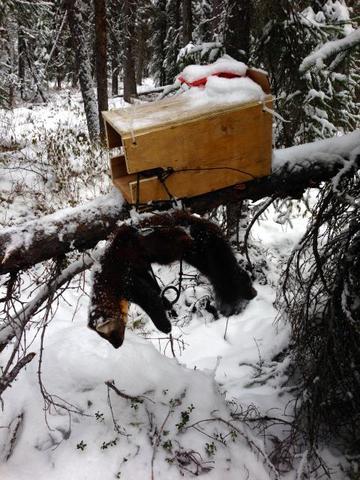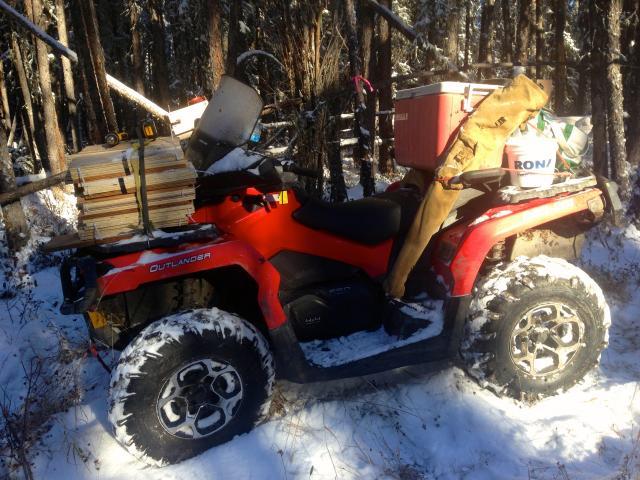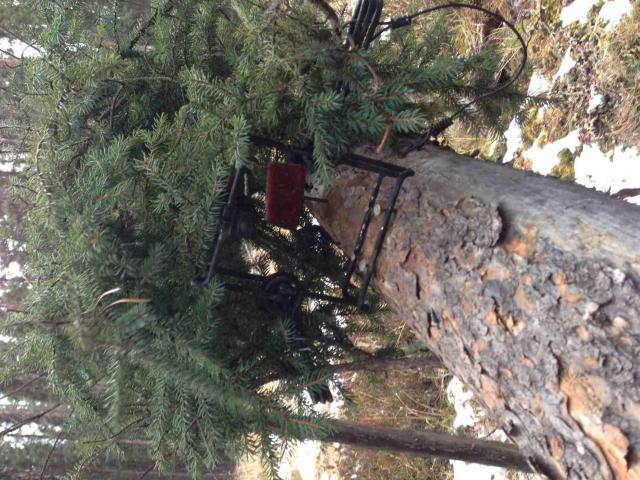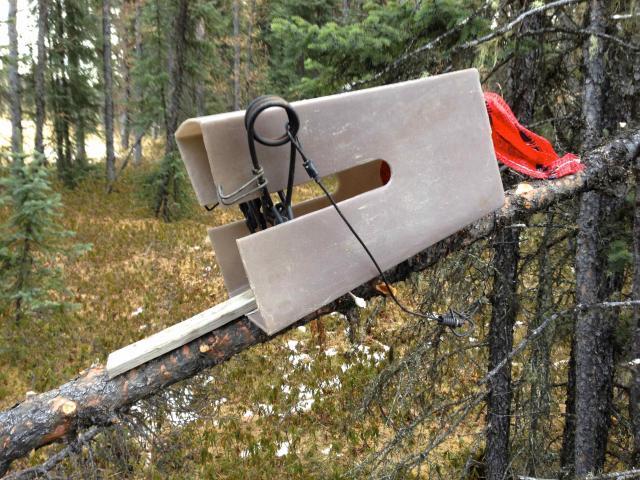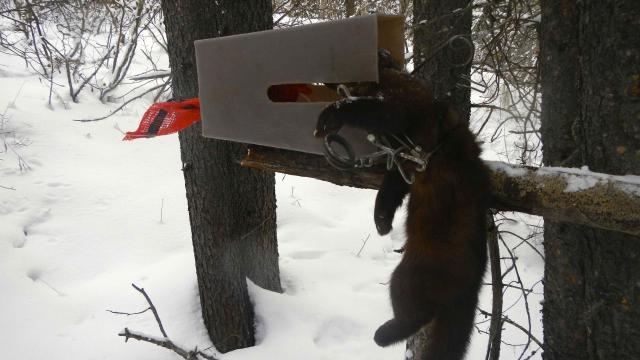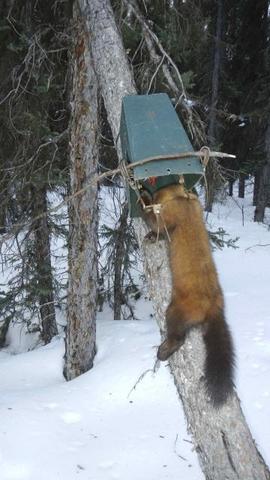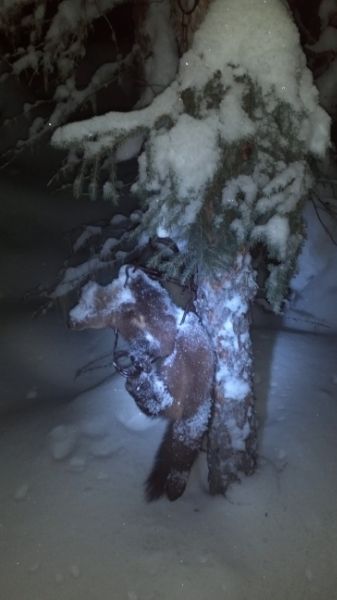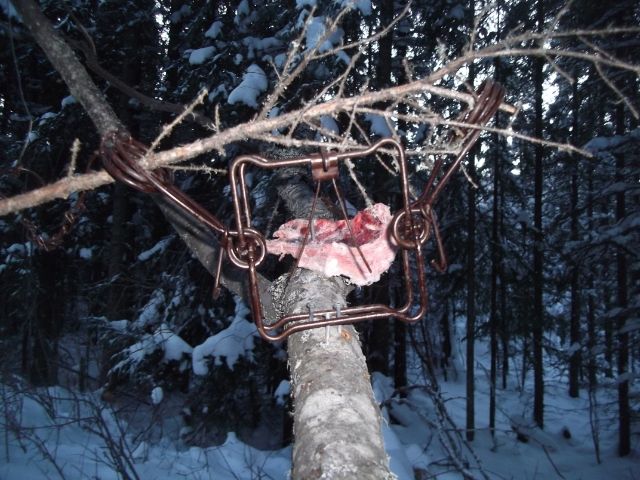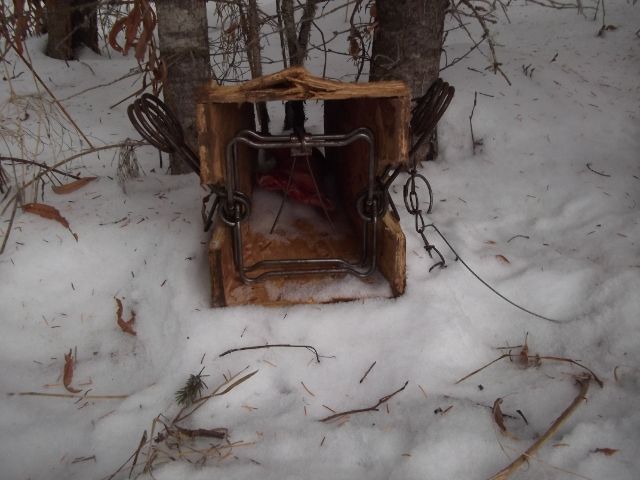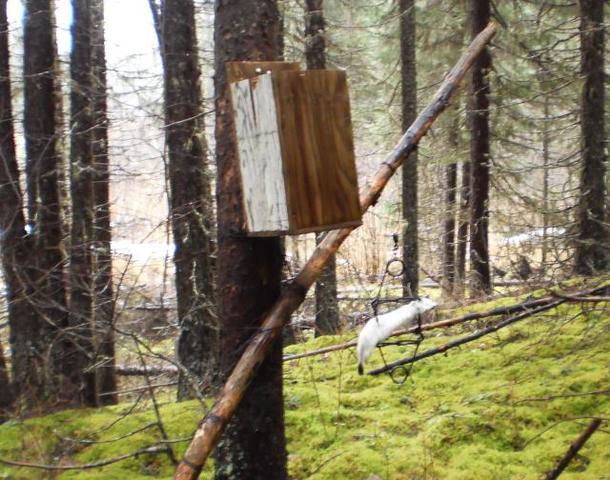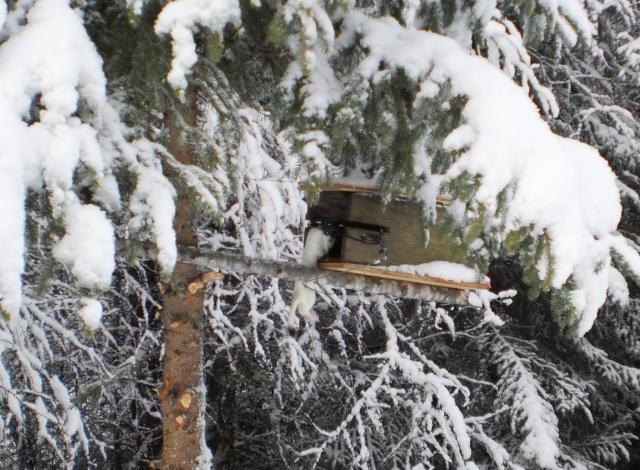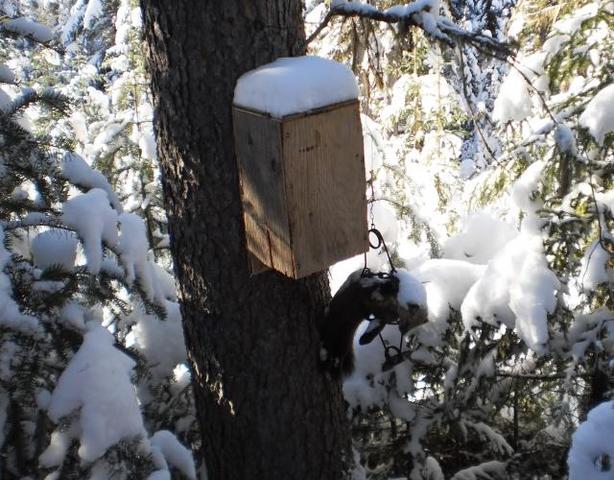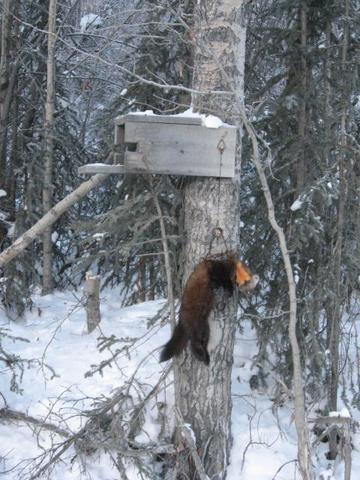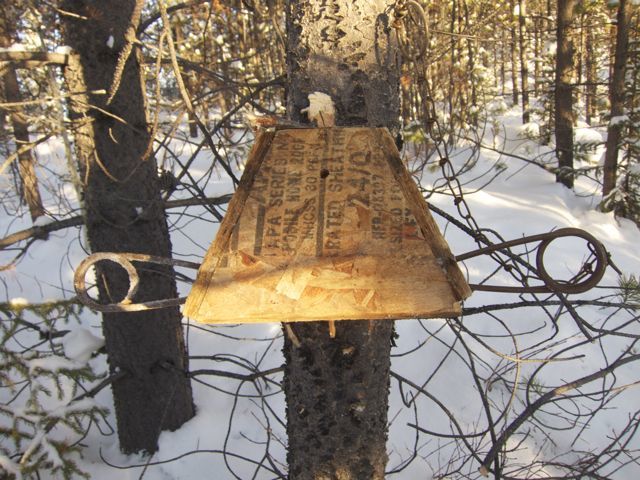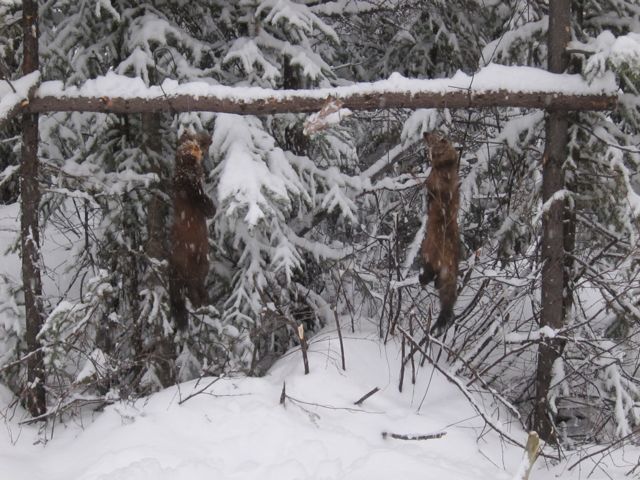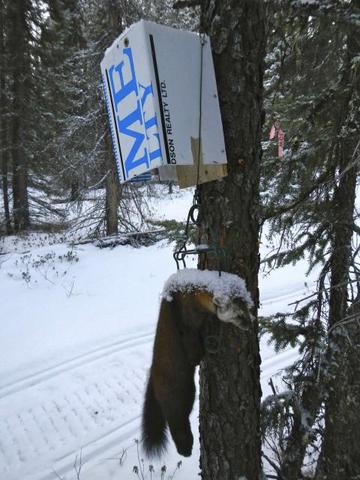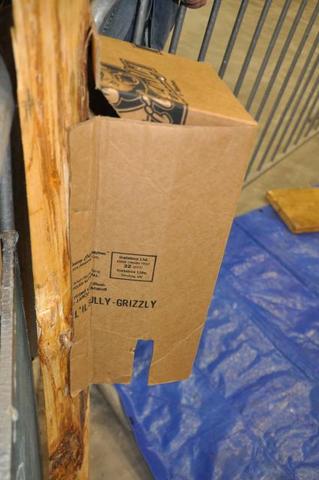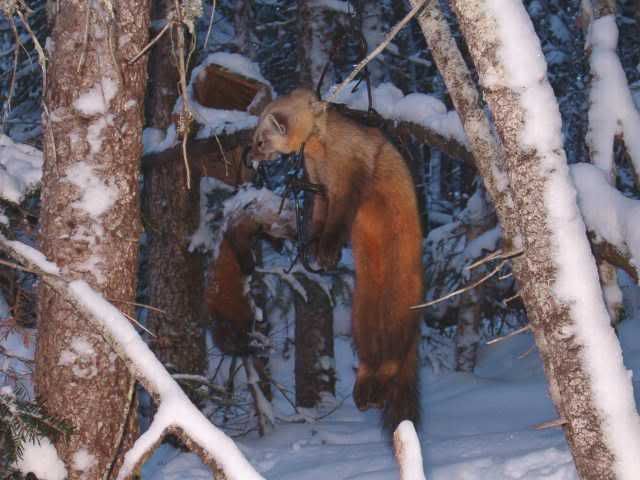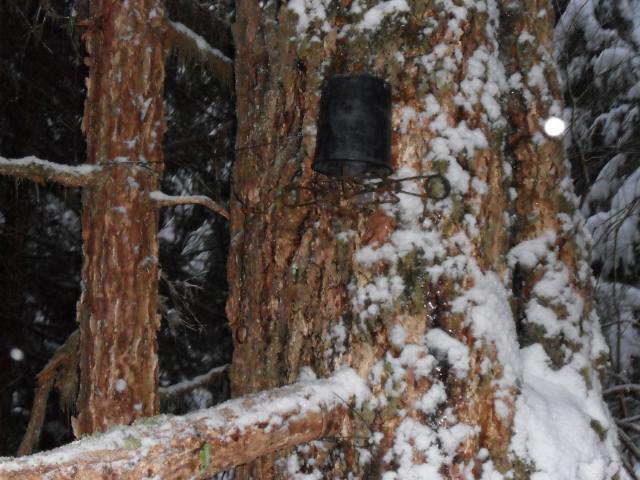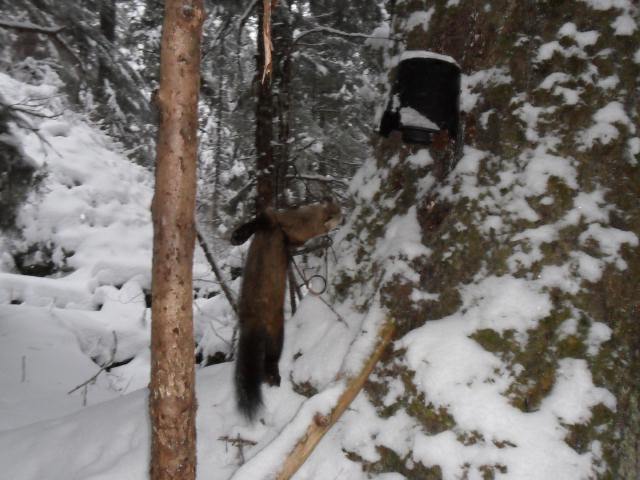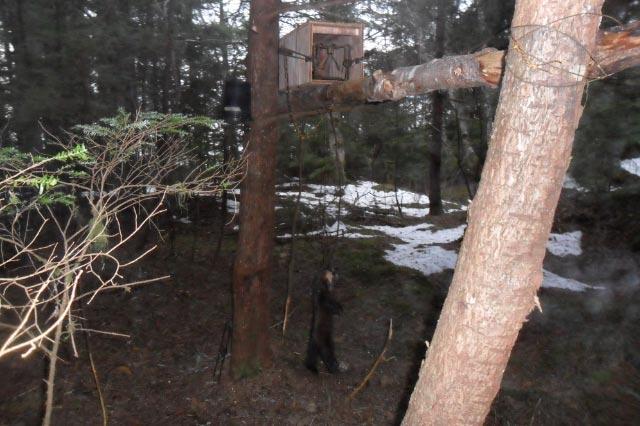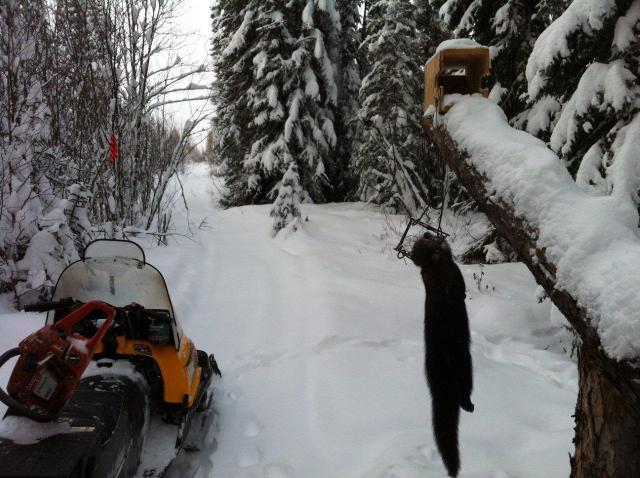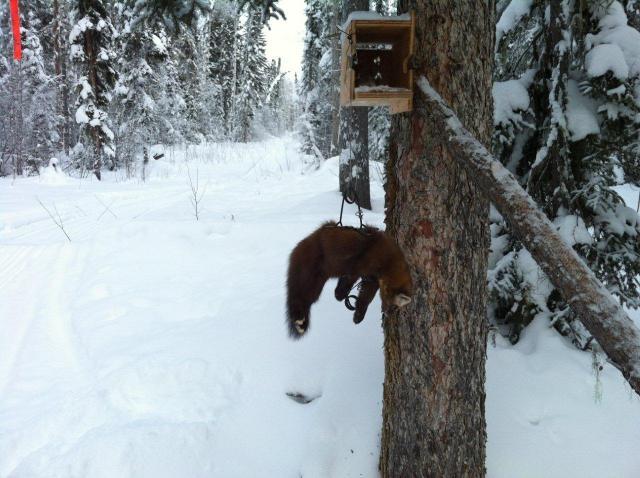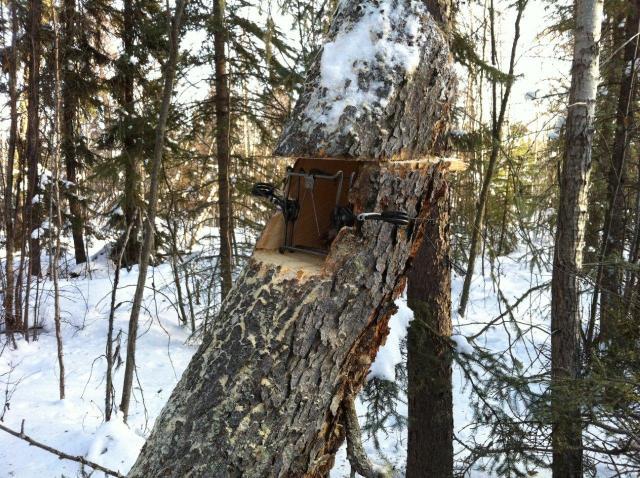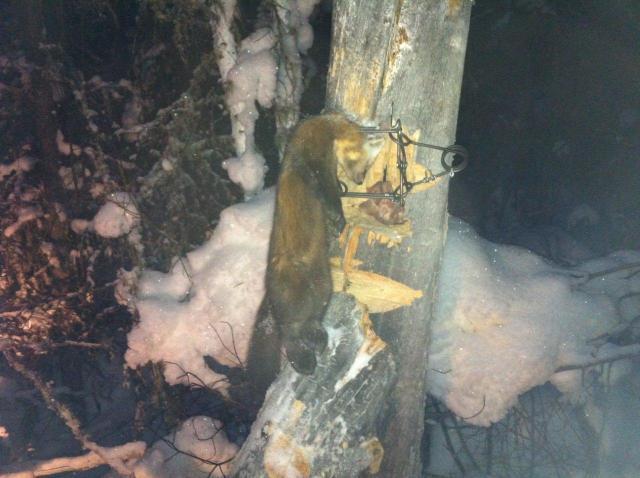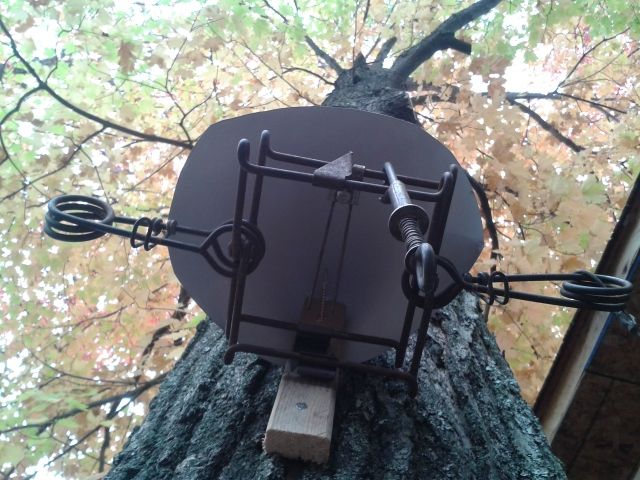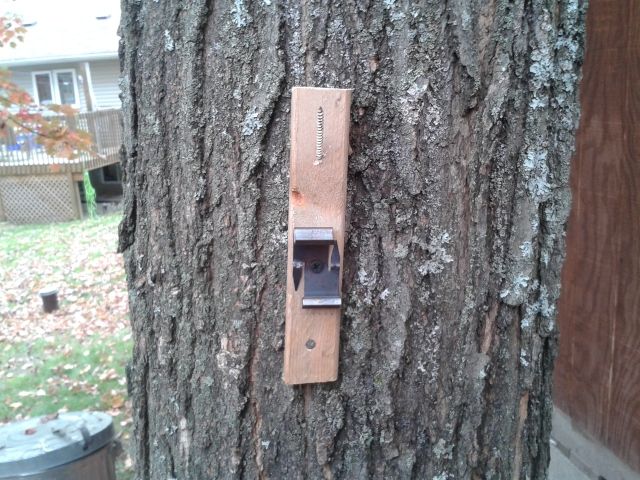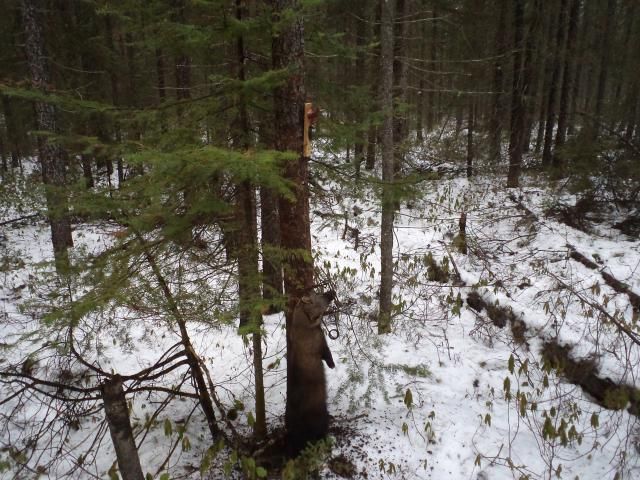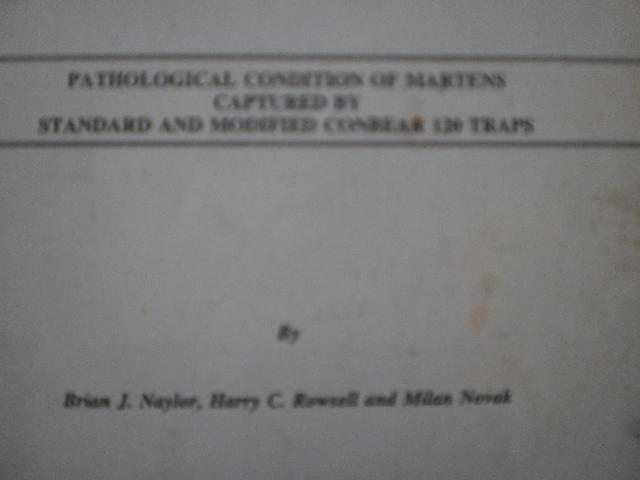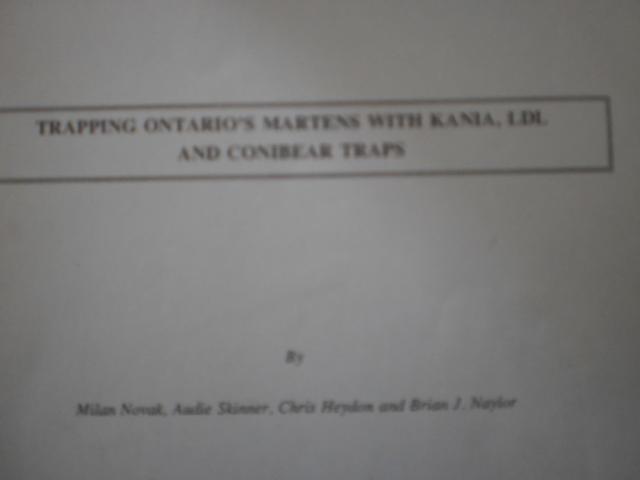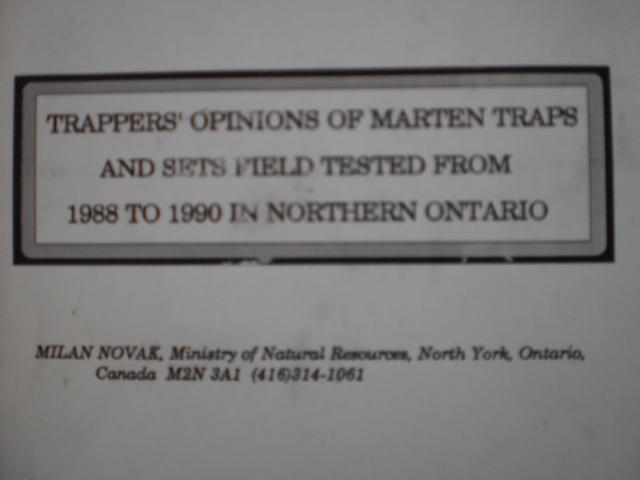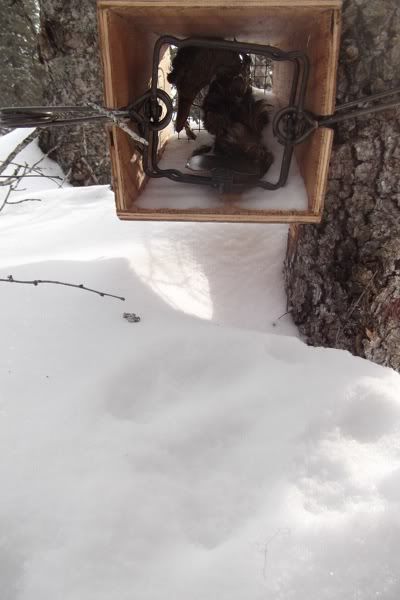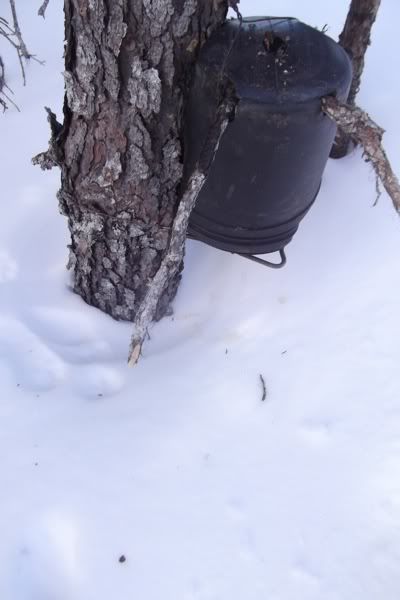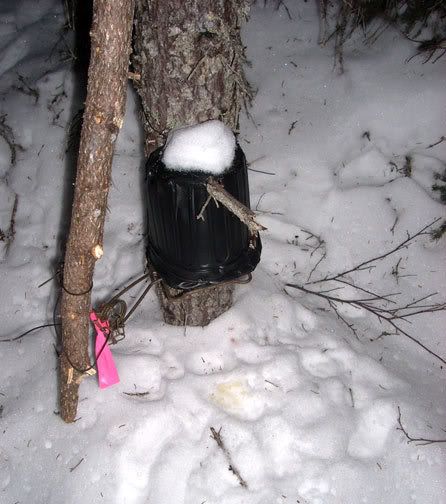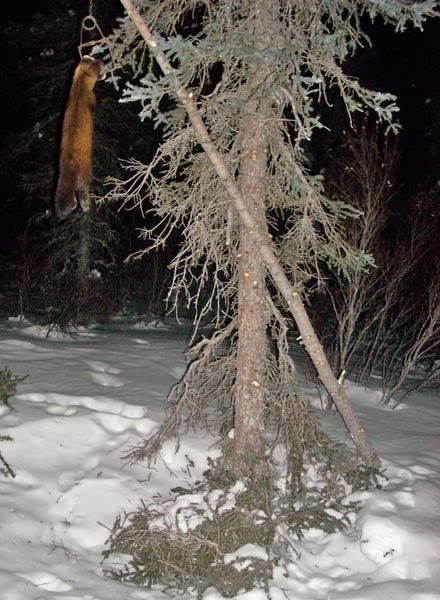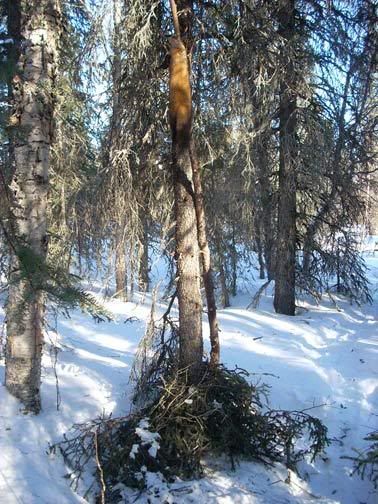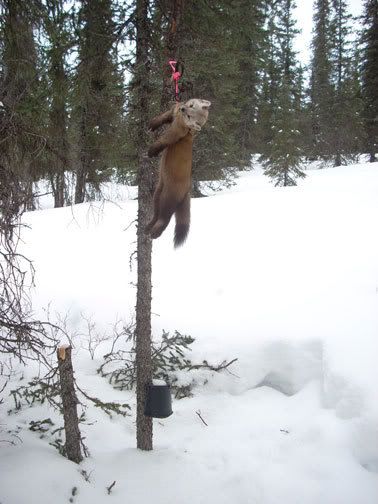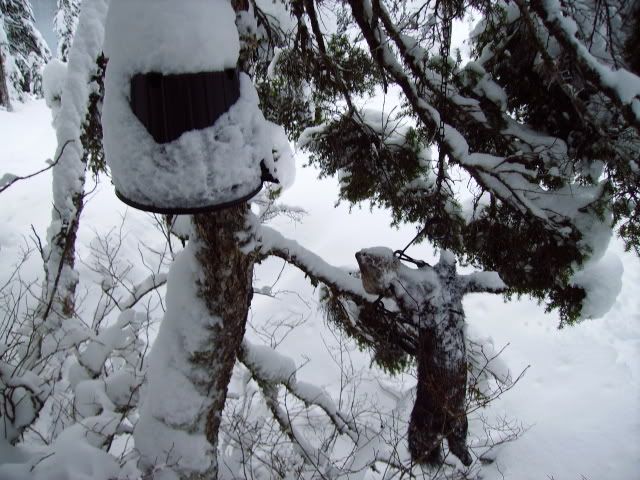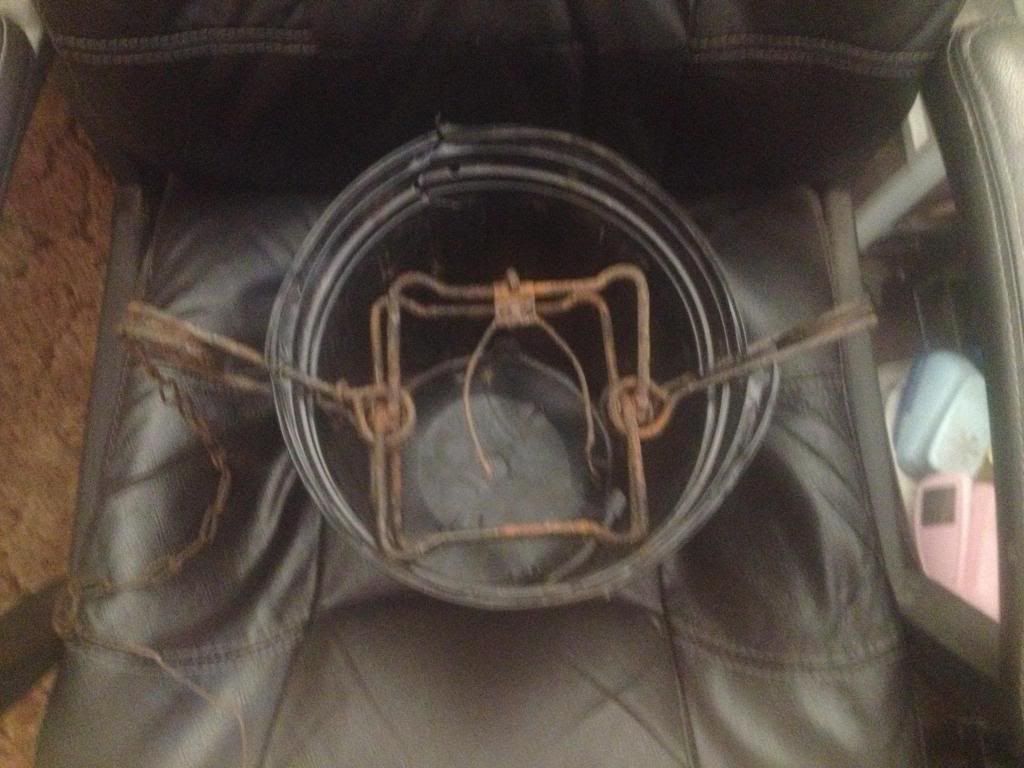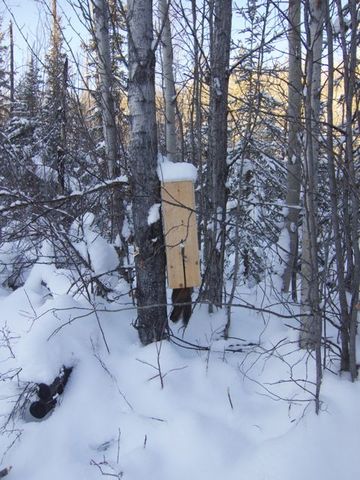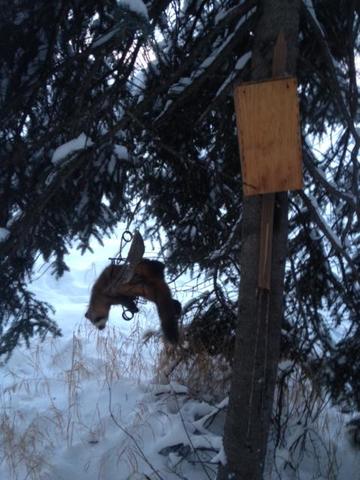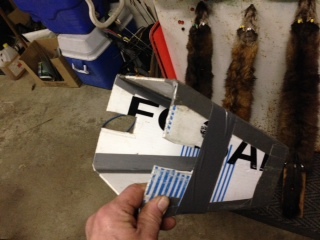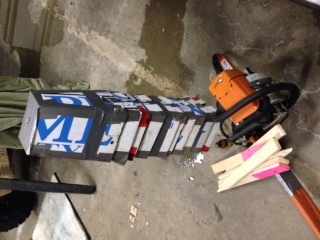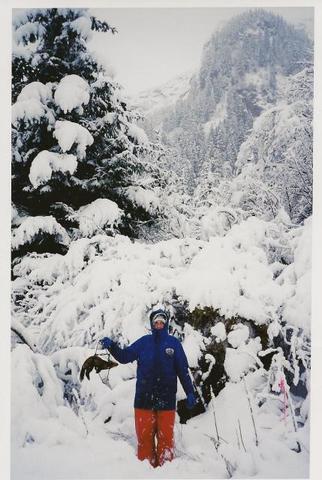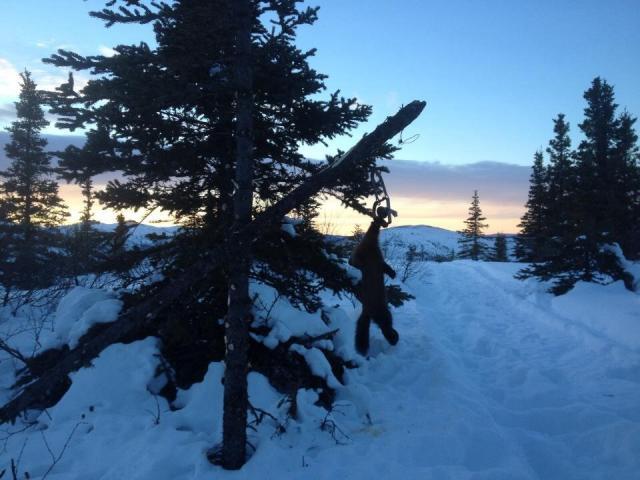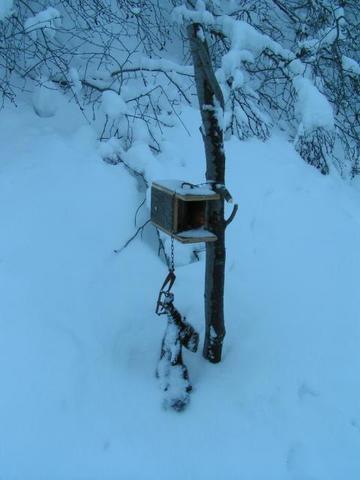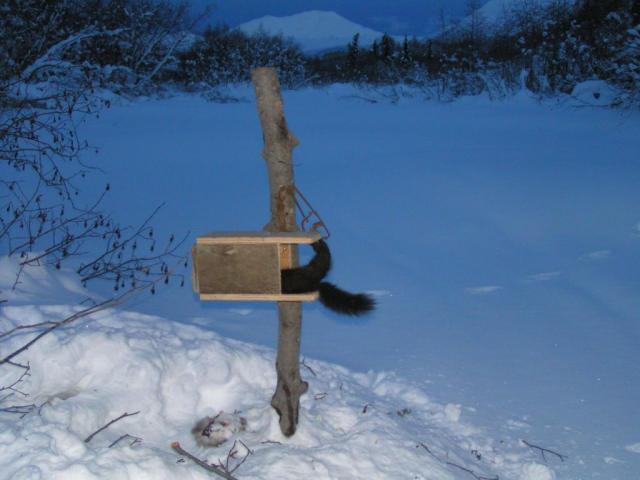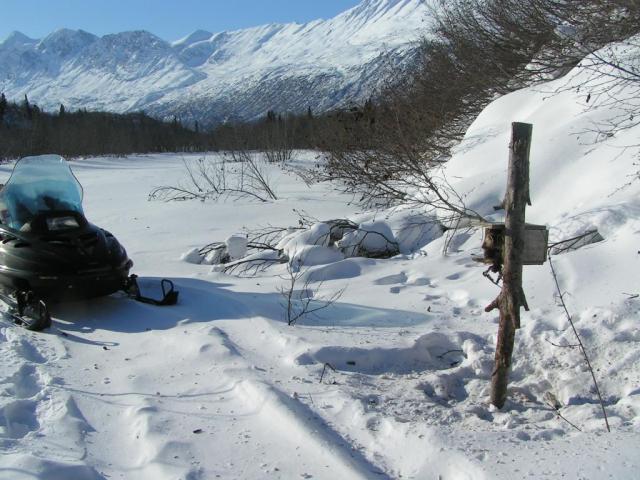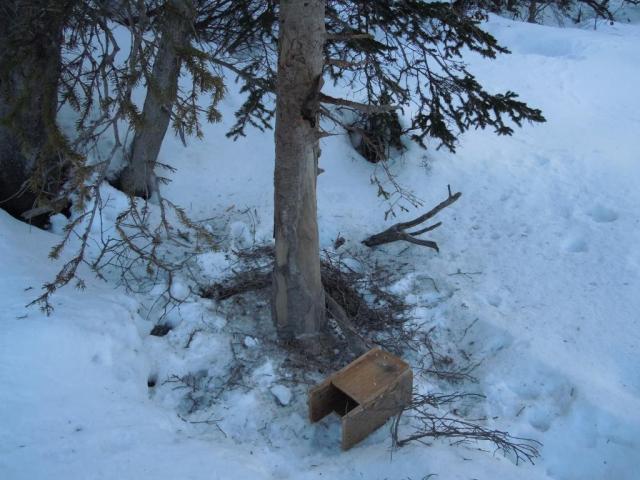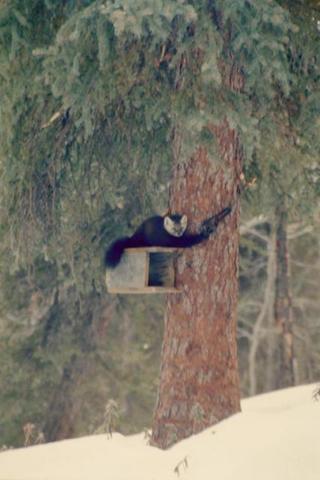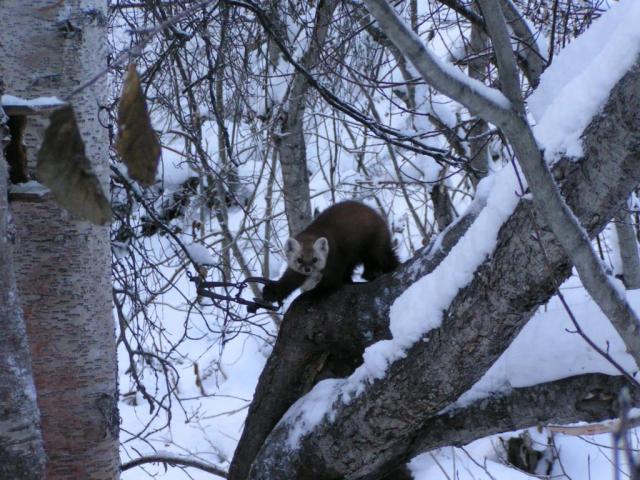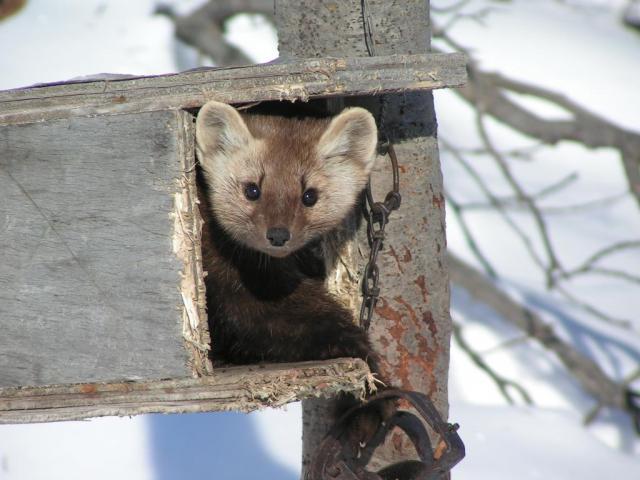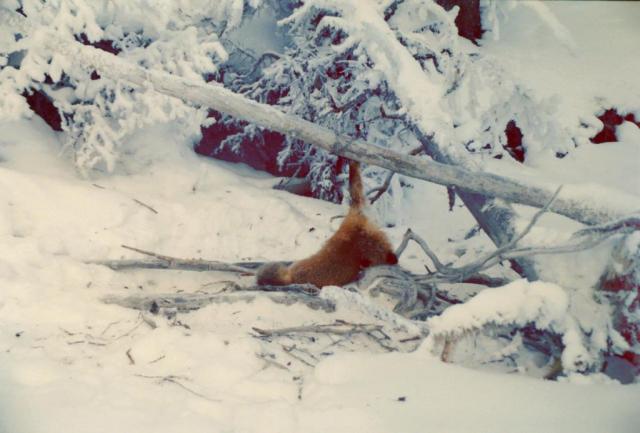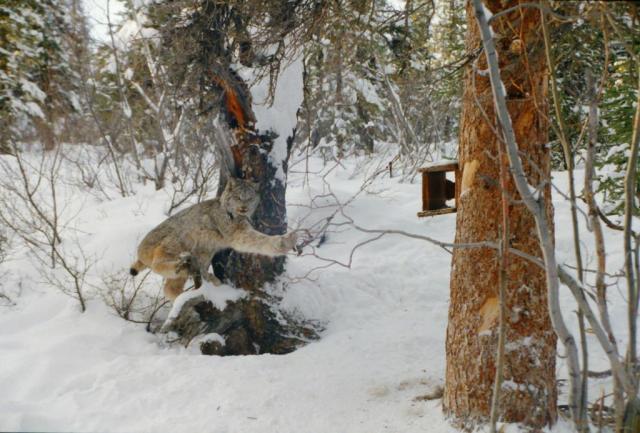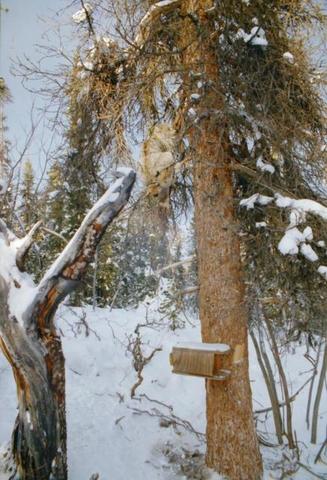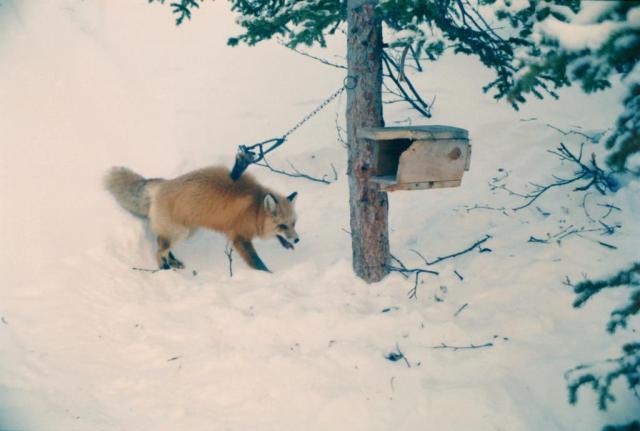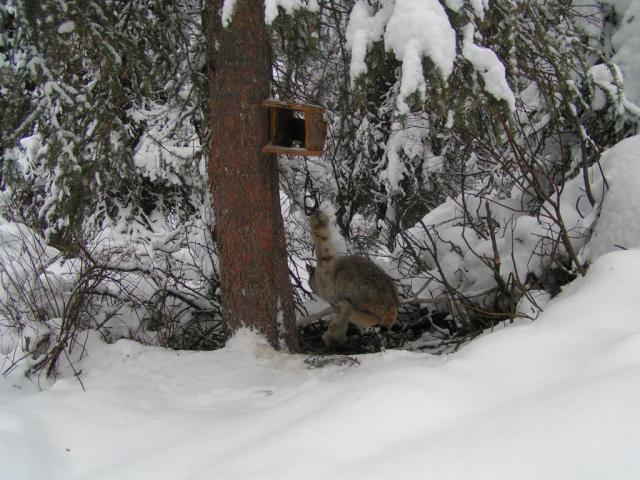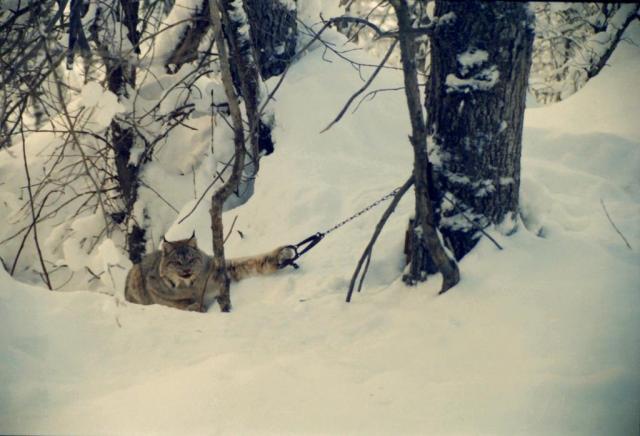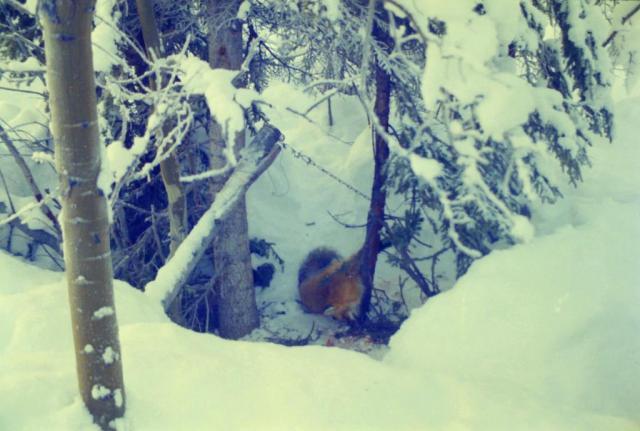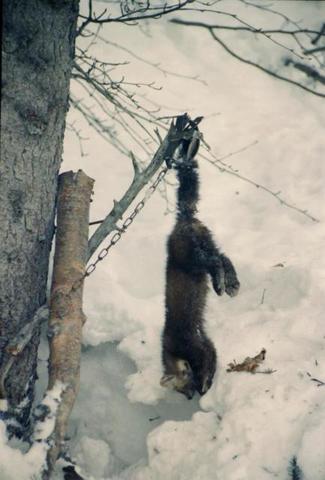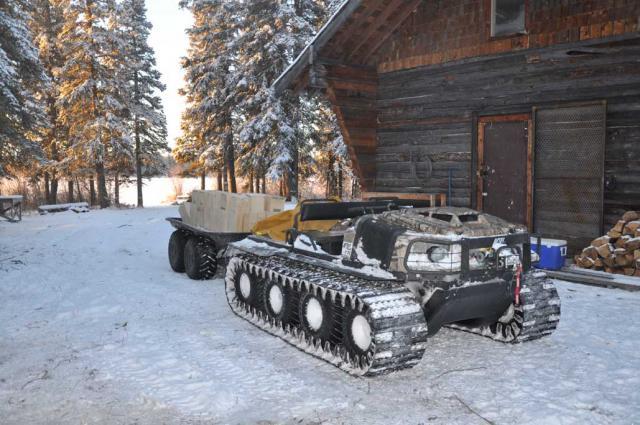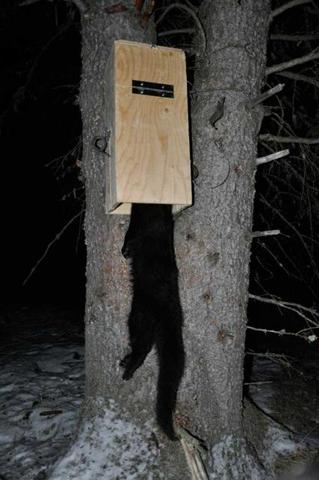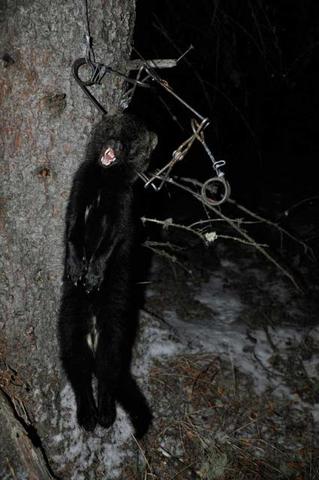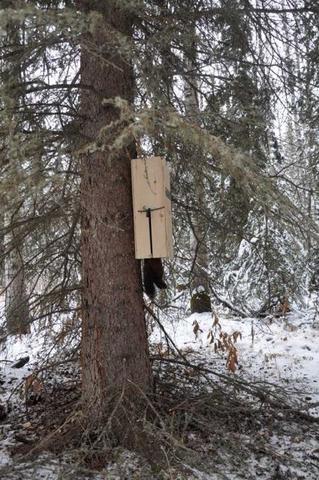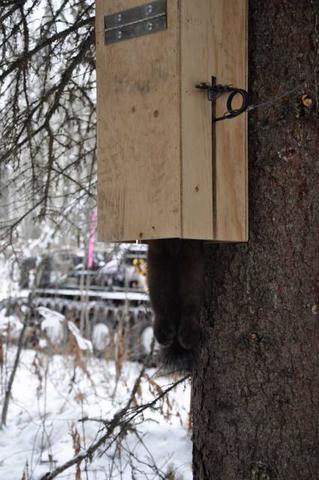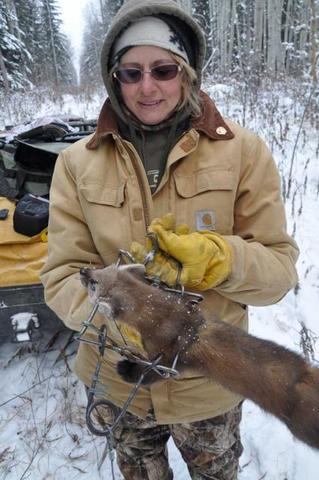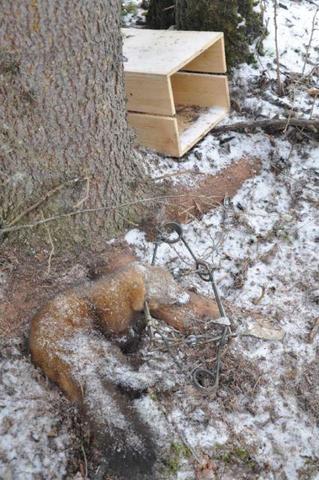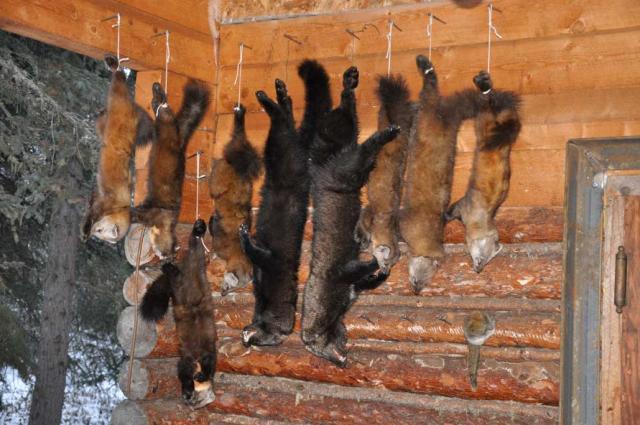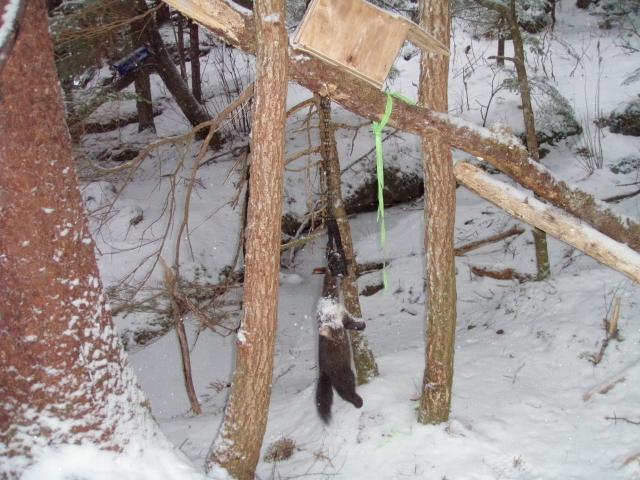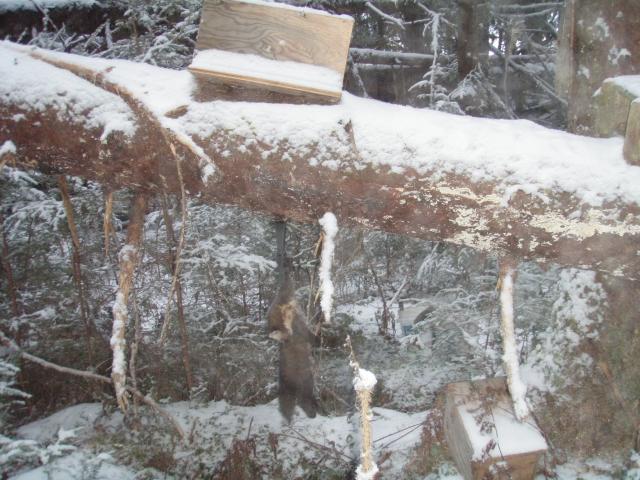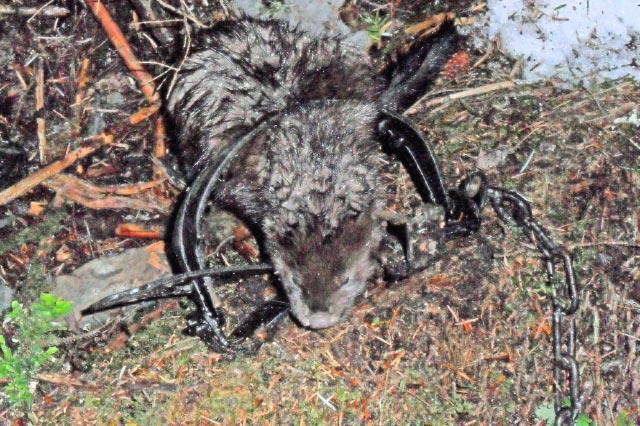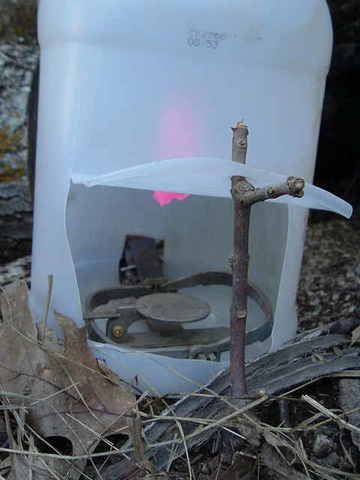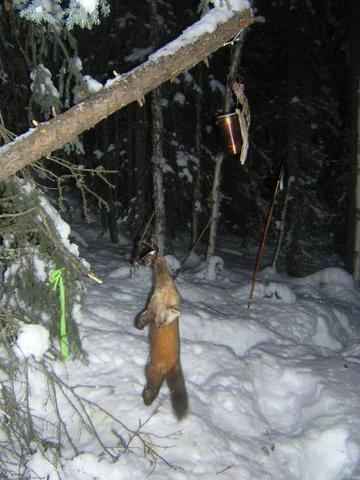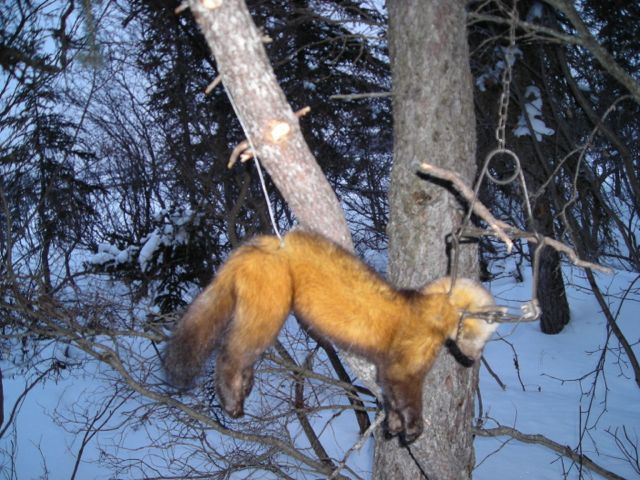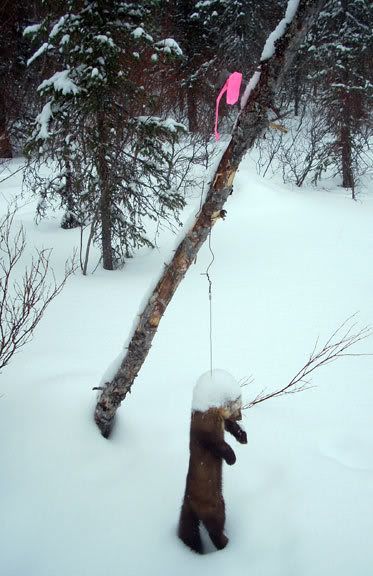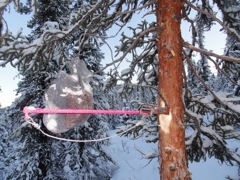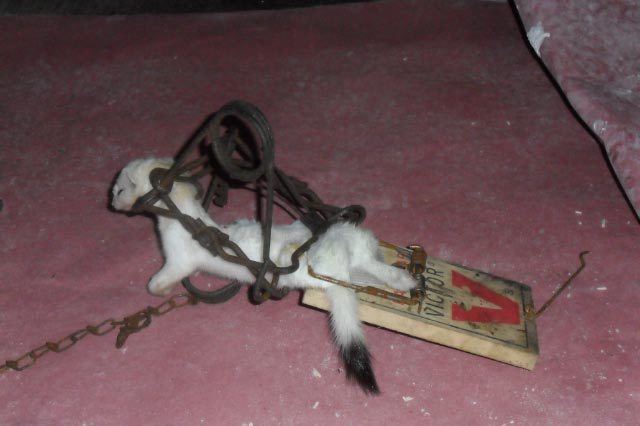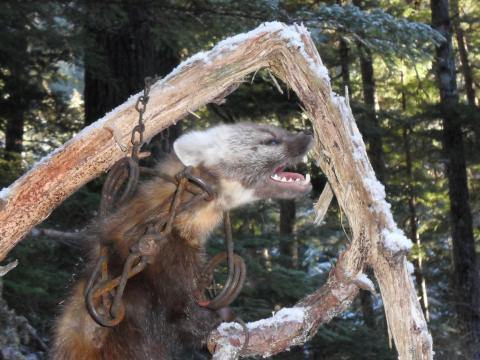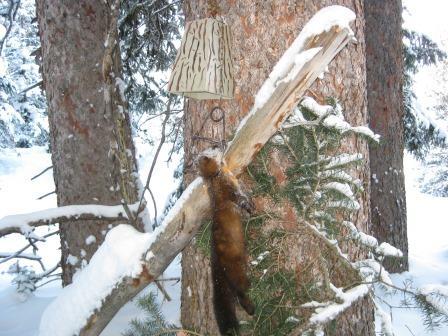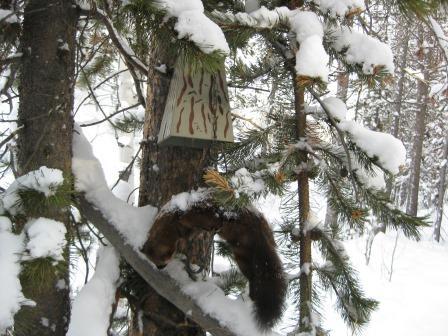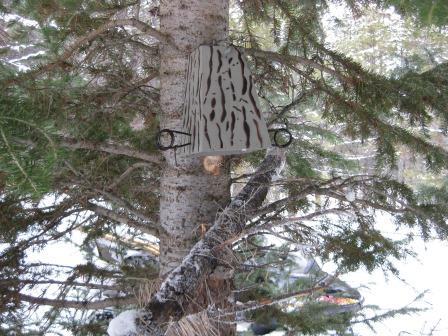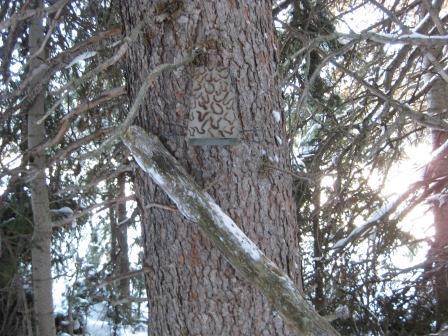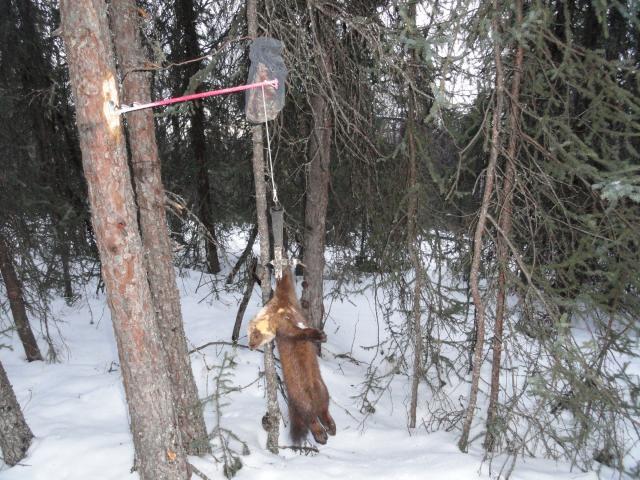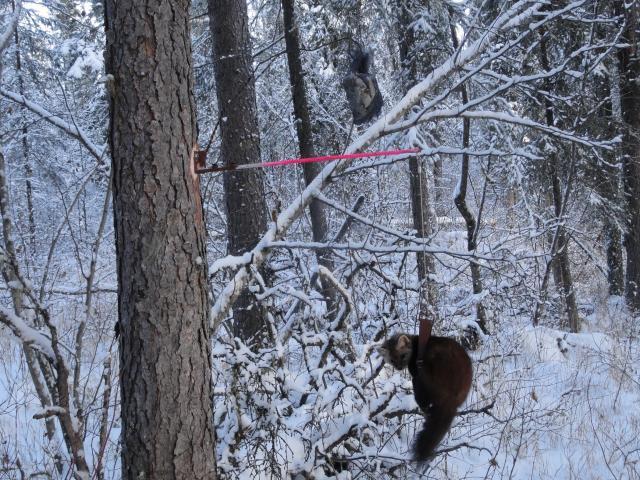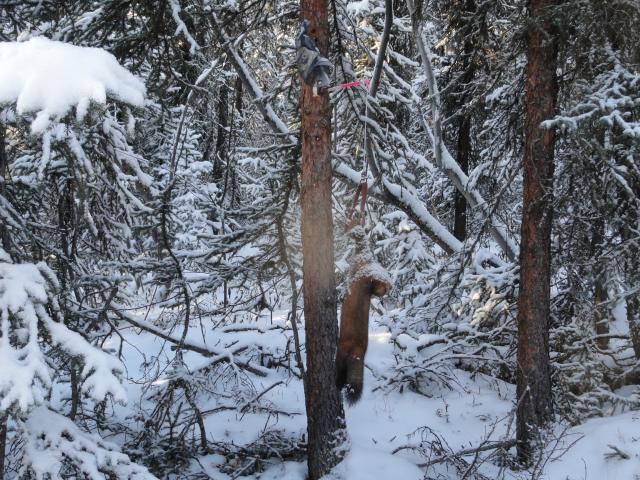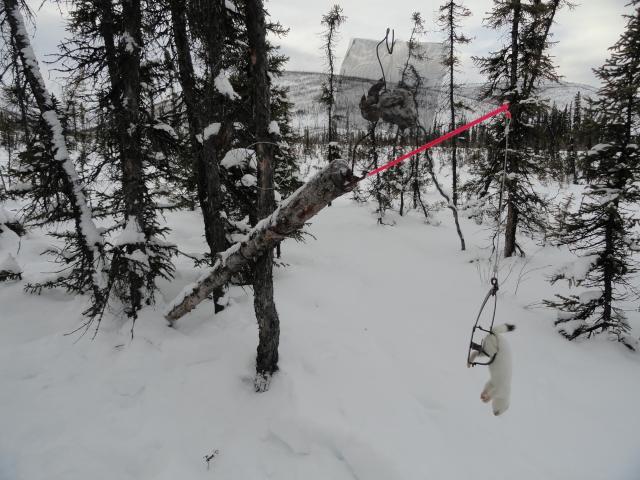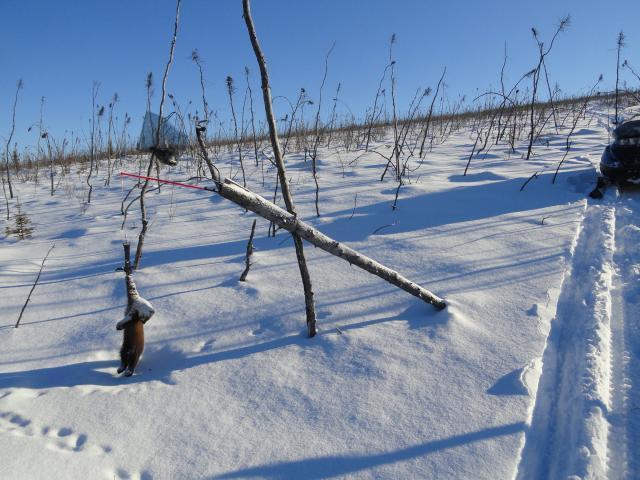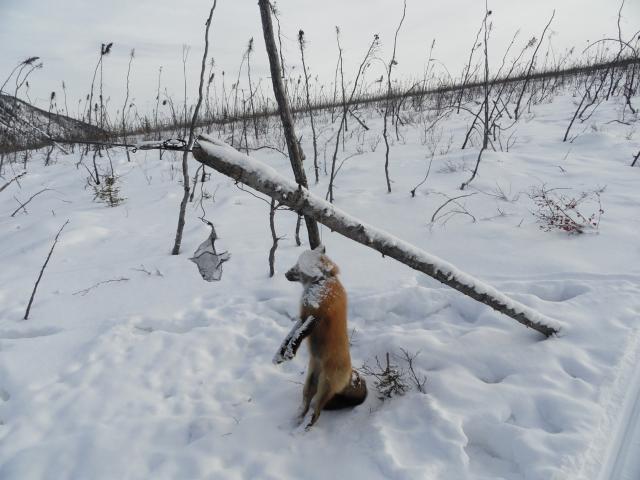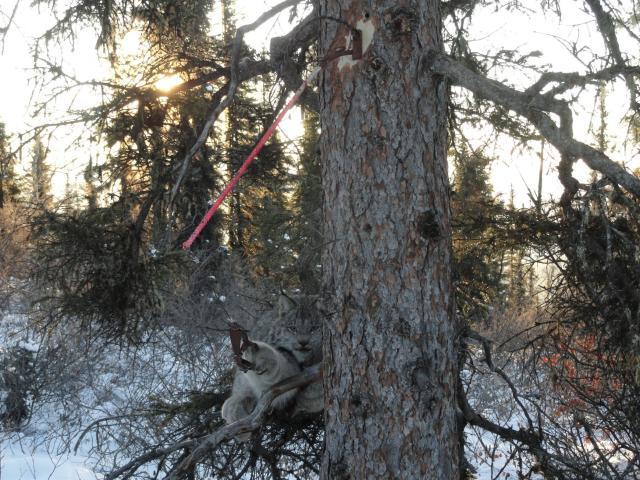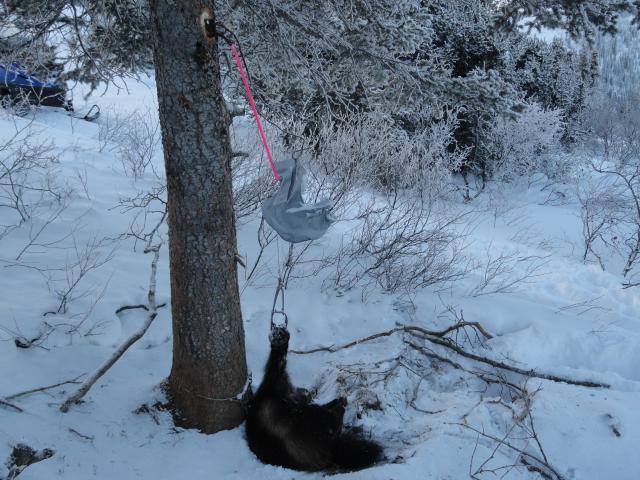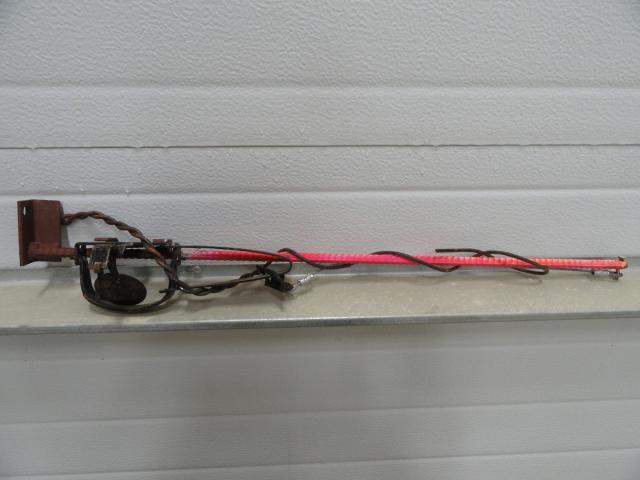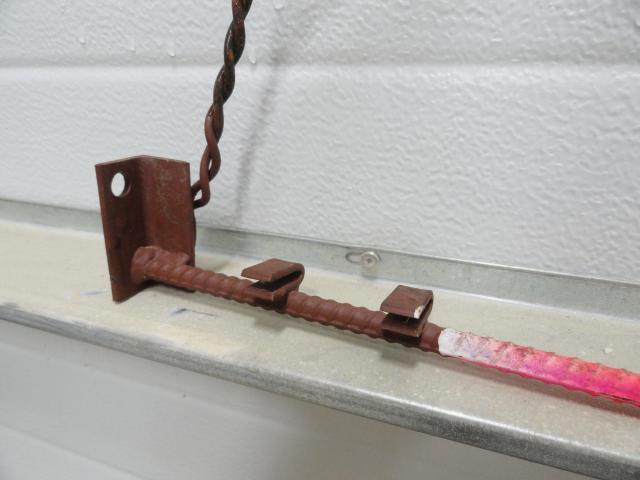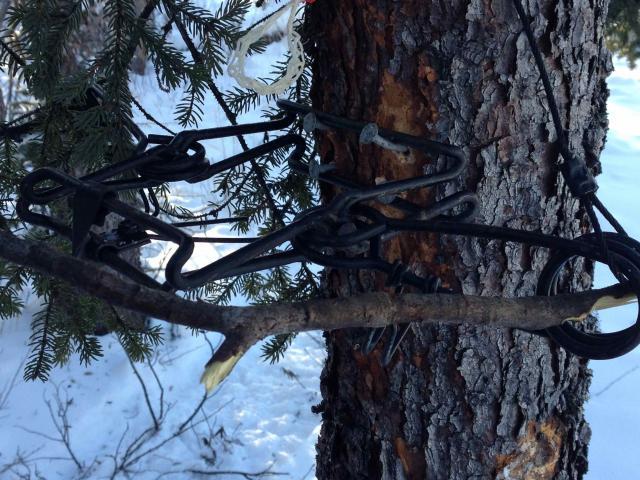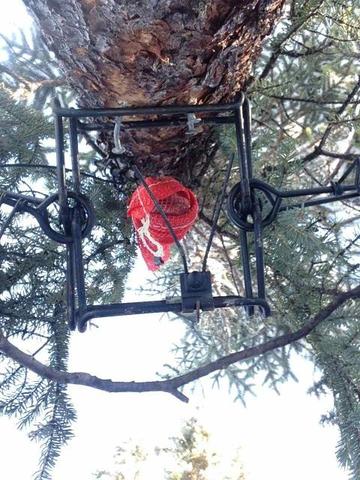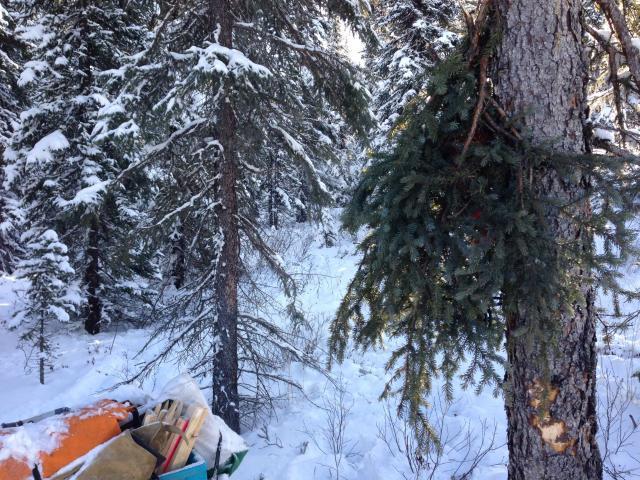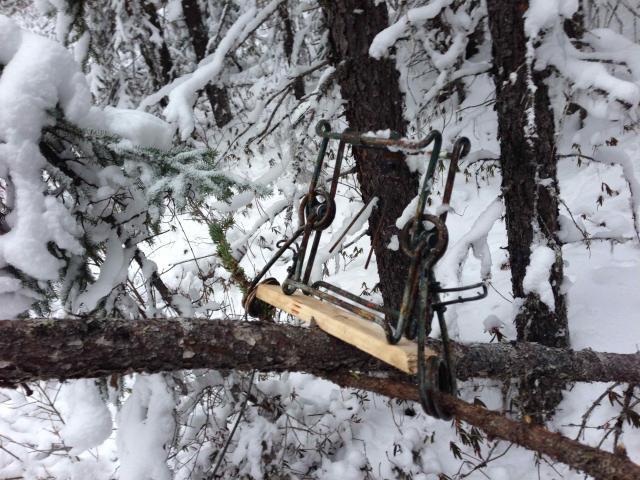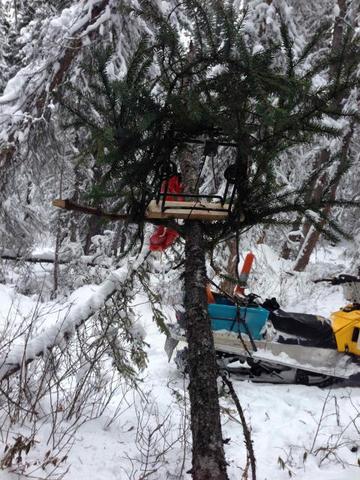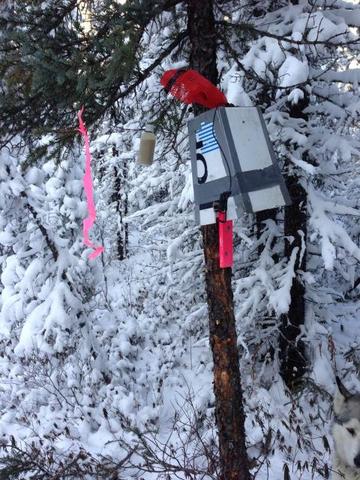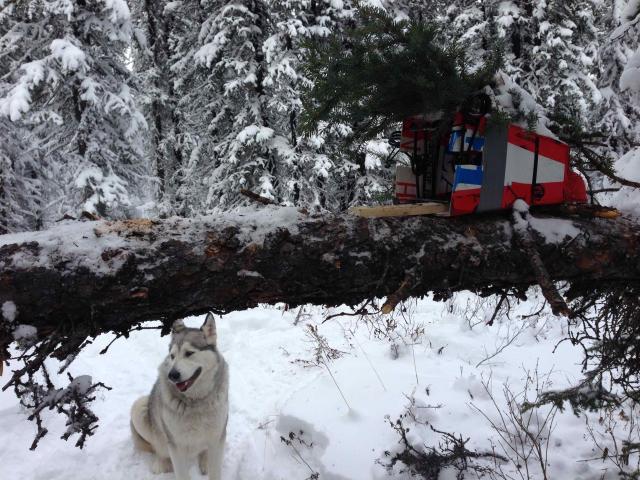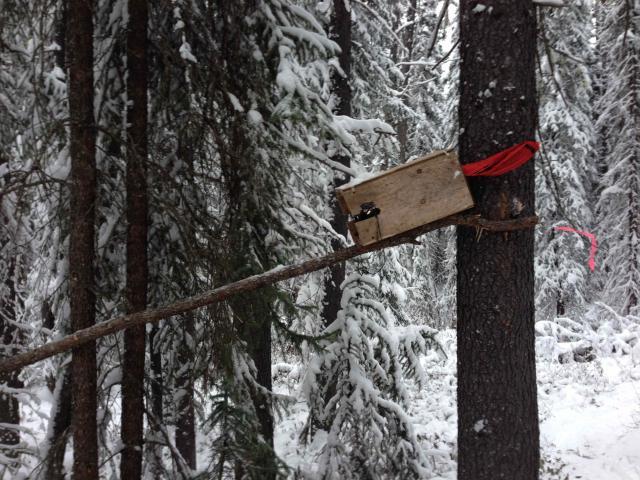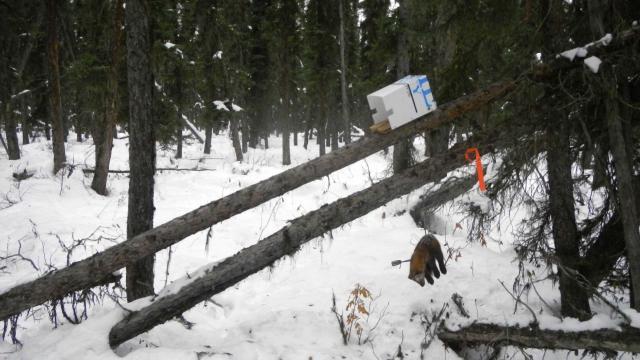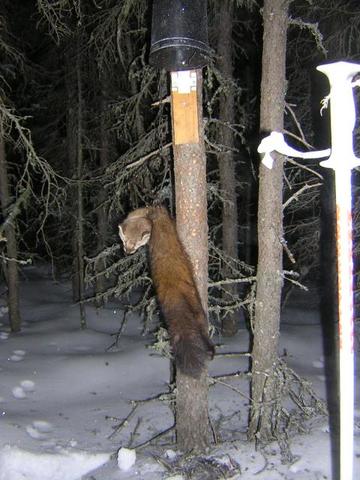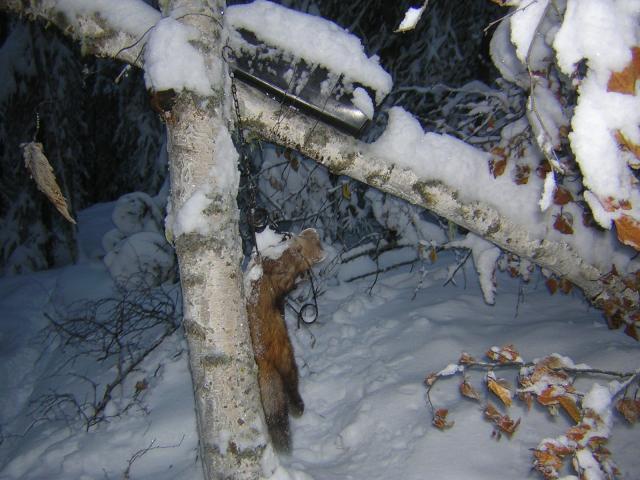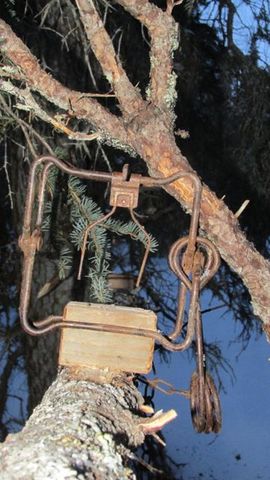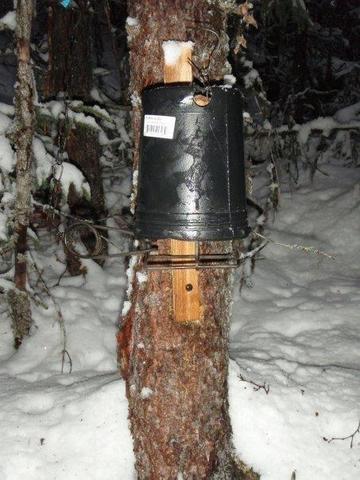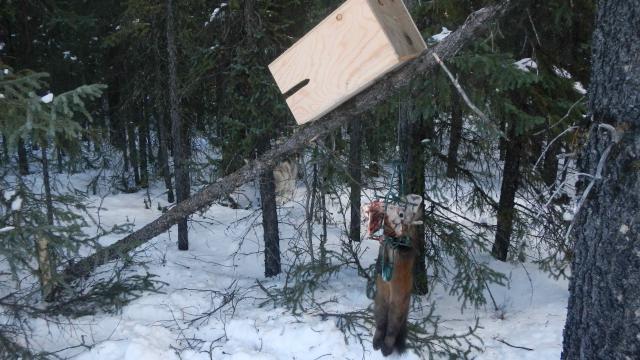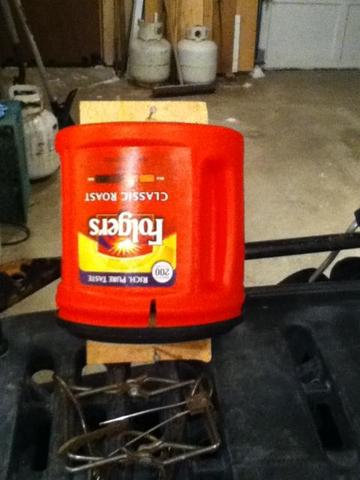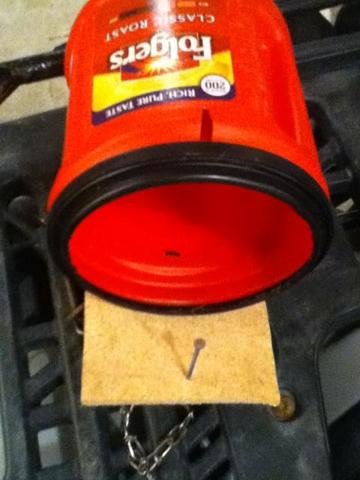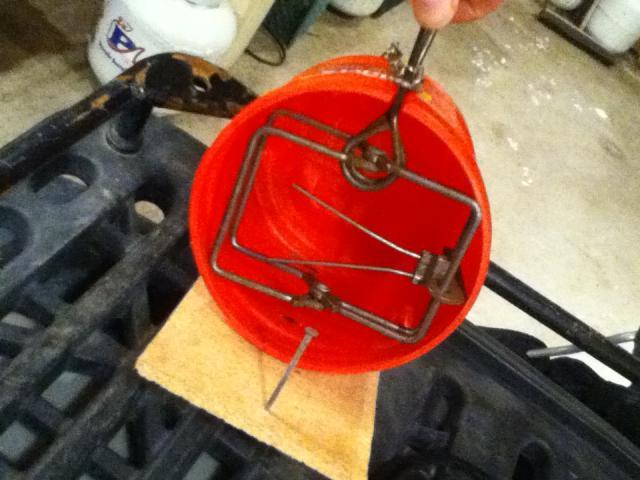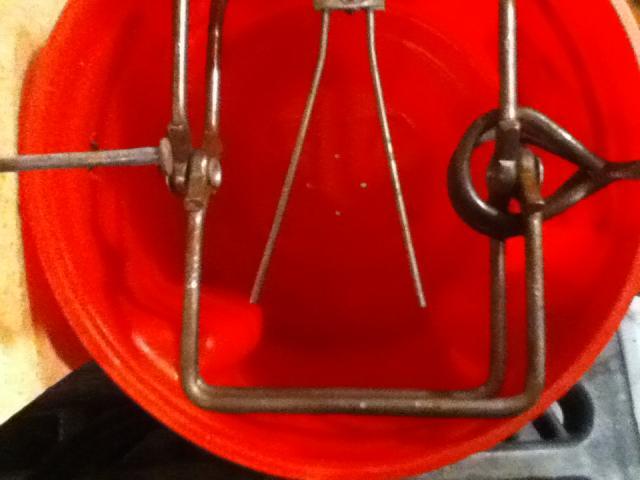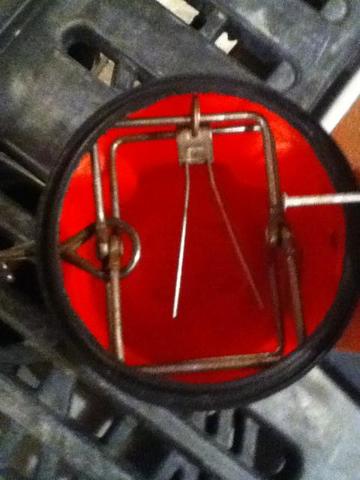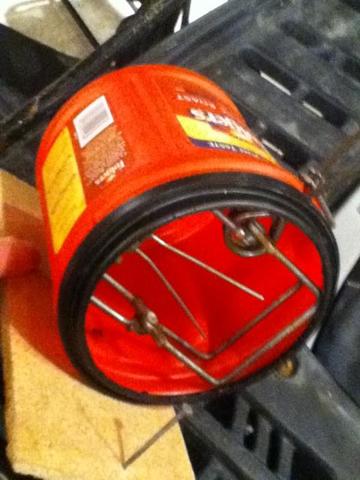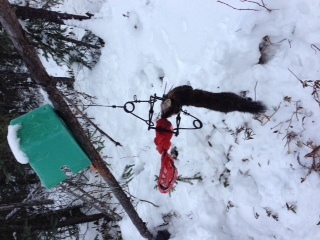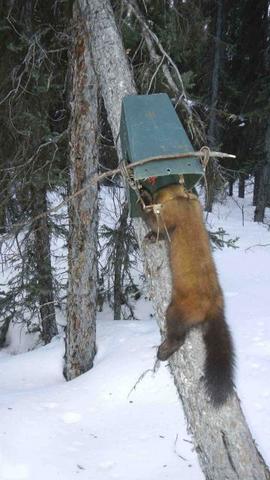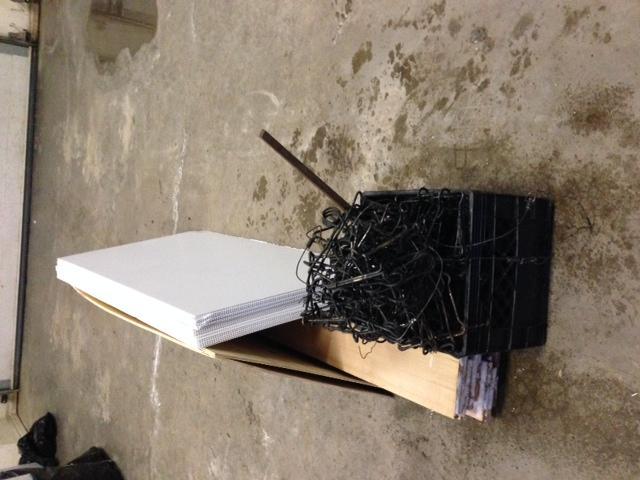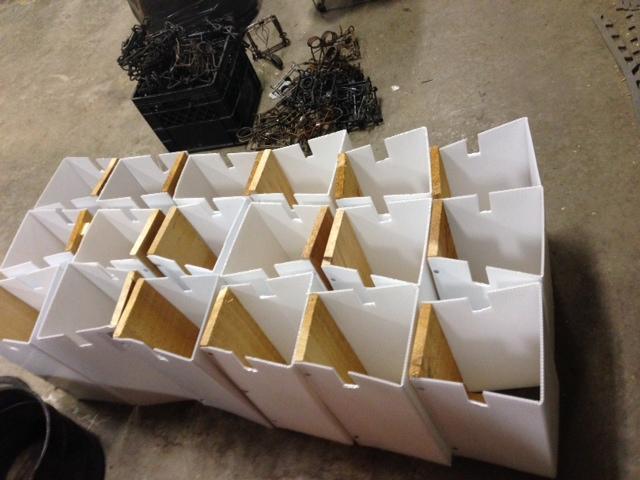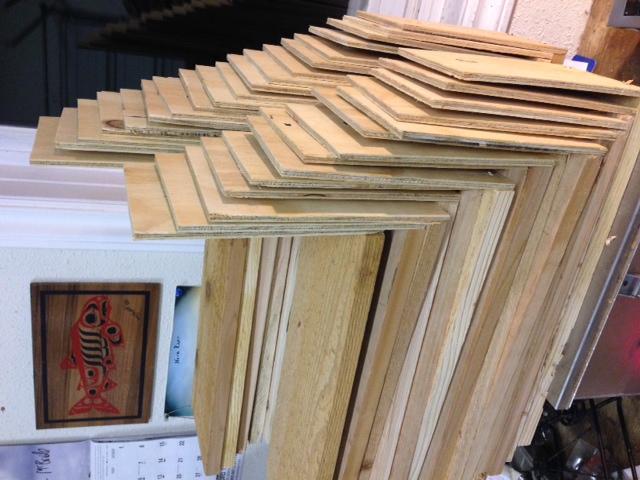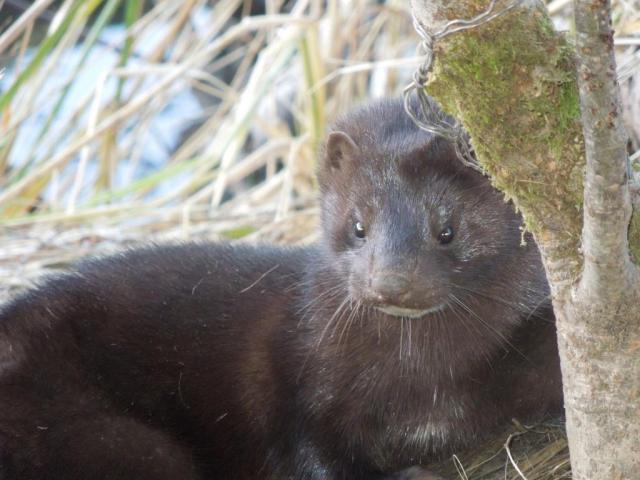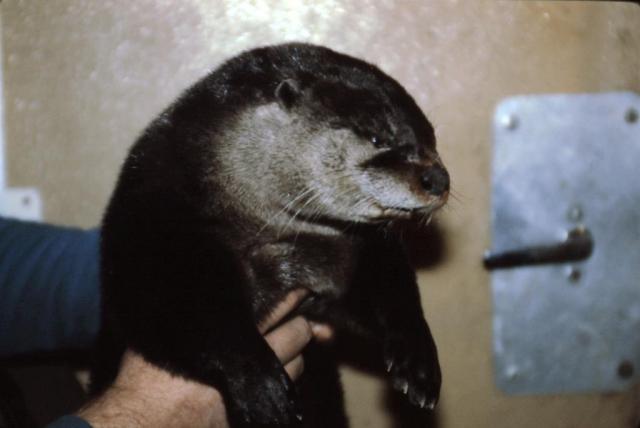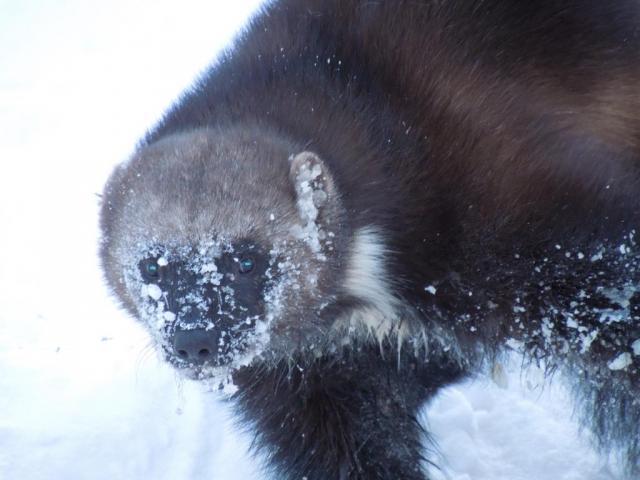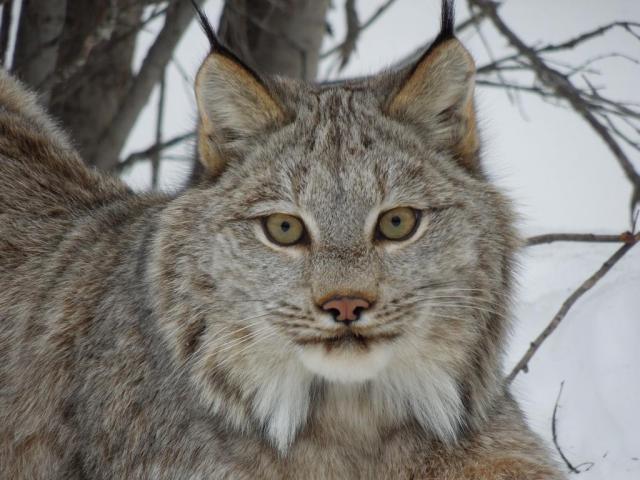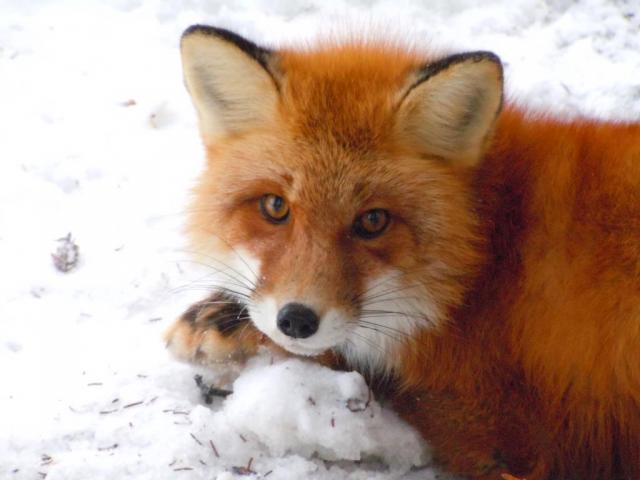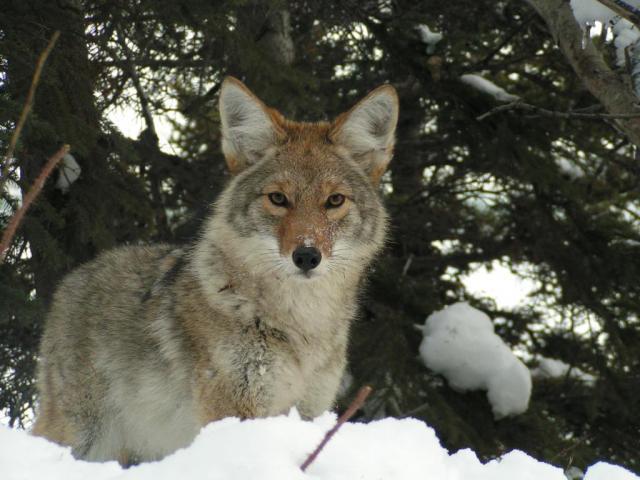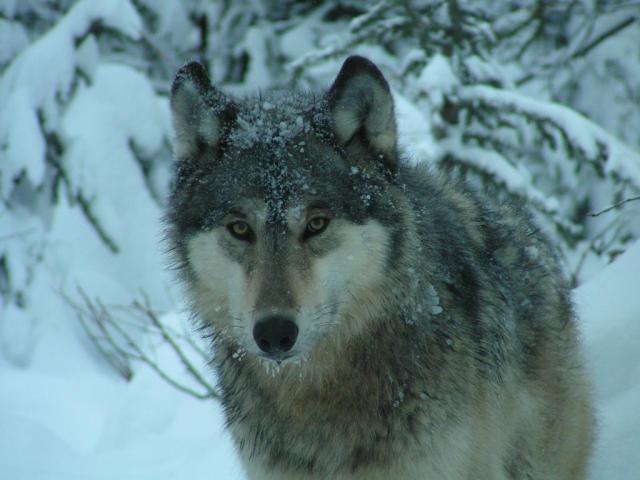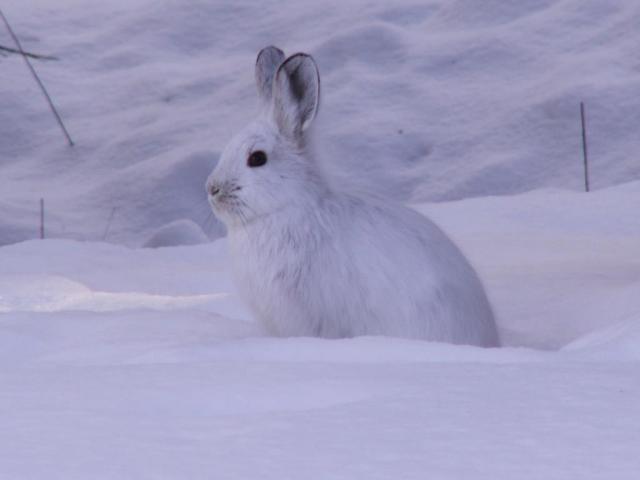My buddy had sent me this study. Food for thought.
Using colour to increase stoat (Mustela
erminea) trap catch
DOC SCIENCE INTERNAL SERIES 187
Billy Hamilton
Published by
Department of Conservation
PO Box 10-420
Wellington, New Zealand
DOC Science Internal Series is a published record of scientific research carried out, or advice given, by
Department of Conservation staff or external contractors funded by DOC. It comprises reports and
short communications that are peer-reviewed.
Individual contributions to the series are first released on the departmental website in pdf form.
Hardcopy is printed, bound, and distributed at regular intervals. Titles are also listed in the DOC
Science Publishing catalogue on the website, refer
http://www.doc.govt.nz under Publications, then
Science and Research.
© Copyright September 2004, New Zealand Department of Conservation
ISSN 1175–6519
ISBN 0–478–22606–3
In the interest of forest conservation, DOC Science Publishing supports paperless electronic
publishing. When printing, recycled paper is used wherever possible.
This report was prepared for publication by DOC Science Publishing, Science & Research Unit; editing
by Helen O’Leary and Geoff Gregory and layout by Geoff Gregory. Publication was approved by the
Manager, Science & Research Unit, Science Technology and Information Services, Department of
Conservation, Wellington.
CONTENTS
Abstract 5
1. Introduction 6
1.1 Sensory attractants in baits 7
1.2 Objectives 7
2. Methods 8
2.1 Trapping 8
2.2 Statistical analysis 8
2.2.1 Site or colour difference in trap catch 9
2.2.2 Effect of sex on capture probability 9
3. Results 9
3.1 Trapping 9
3.2 Trap catch and site differences 10
3.3 Trap catch and trap colours 10
3.4 Trap catch for bright and dull covers 11
3.5 Trap catch and sex bias 11
3.6 Bycatch 12
4. Discussion 12
5. Recommendations 13
6. Acknowledgements 14
7. References 14
DOC Science Internal Series 187 5
© September 2004, New Zealand Department of Conservation. This paper may be cited as:
Hamilton, W. 2004: Using colour to increase stoat (Mustela erminea) trap catch. DOC Science
Internal Series 187. Department of Conservation, Wellington. 15 p.
Using colour to increase stoat (Mustela
erminea) trap catch
Billy Hamilton
Ecological Networks Limited, 10 Coughtrey Street, St Clair, Dunedin
A B S T R A C T
This study compared the effects of four different-coloured trap covers on stoat
(Mustela erminea) trap catch at Okia Reserve and Allens Beach on the Otago
Peninsula, South Island, New Zealand. These sites bordered yellow-eyed
penguin (Megadyptes antipodes) colonies. Kill traps were each placed within a
moulded plastic cover coloured yellow, red, green, or black. All four colours
were equally allocated among the 200 traps, giving 50 covers of each colour.
Traps were baited with rabbit. They were then re-baited and checked every two
days for stoats caught, bycatch of other animals, and disturbed traps. Traps
were left at each site for 20 nights. During the study, 18 stoats (12 female and
six male), two ferrets (M. furo) (one of each sex), eight hedgehogs (Erinaceus
europaeus), and one rabbit (Oryctolagus cuniculus) were caught. Data were
analysed using MatLab™ simulations. There was no statistically significant
difference in trap catch between sites. Stoats had a higher probability of being
caught in traps with yellow covers than those of other colours, and in traps with
bright covers (yellow and red) than in those with duller covers (green and
black).
Keywords: Colour, sex bias, stoats, Mustela erminea, attractants, traps, Otago
Peninsula, New Zealand.
6 Hamilton—Colour as an attractant for trapping stoats
1. Introduction
New Zealand’s ecological communities have evolved in the absence of
mammalian predators for over 80 million years. Its flora and fauna are especially
vulnerable to introduced mammalian pests (Holdaway 1989), such as stoats
(Mustela erminea), ferrets (M. furo), weasels (M. nivalis), cats (Felis catus),
mice (Mus musculus), rats (Rattus spp.), and hedgehogs (Erinaceus
europaeus) have become major predators of New Zealand’s native birds,
lizards, and/or invertebrates (Gibb & Flux 1973; King 1990; McLennan et al.
1996). Of these introduced pests, stoats are now considered one of the most
important predators of native avifauna in New Zealand (King 1984; O’Donnell
et al. 1996).
To combat the effects of stoats and other introduced vertebrate pests and to
preserve and/or enhance indigenous biodiversity, control measures have
become important aspects of conservation within New Zealand. With respect to
stoats, labour-intensive trapping and poisoning have been the main methods of
control. These control operations can be expensive, and any methods that can
be developed to maximise cost-effectiveness are not only common sense but
also a requirement for any responsible conservation management team.
Stoats are relatively solitary animals and tend to occur at relatively low
abundances within New Zealand (Murphy 1996). These characteristics,
together with their capabilities for wide dispersal and delayed implantation,
combined with problems in trapping this species in late winter and spring (King
& Moody 1982), mean that stoat control operations are both difficult and
expensive. Therefore trapping and poison operations should be focused and
take into consideration any behavioural characteristics that make the target
animal more vulnerable to the control methodology.
In the past, control station placement (Doyle 1990; Murphy & Dowding 1995;
Dilks et al. 1996), spacing and layout of traps (Lawrence & O’ Donnell 1999),
and the use of specific baits and lures, have all been trialed to increase the
efficacy of stoat control. Baits and pheromone-based lures in part ‘reward’ the
animal for entering a control station. They can also increase the station’s ‘area
of influence’, as can non-olfactory attractants, thereby increasing both the trap
catch in the ‘area of influence’ and the ability to trap without increasing the
number of traps in an area. Efficacy may then be improved while costs remain
constant.
Baits are often based on the food source that is available to the target animal.
This can be the prey item of highest abundance within an area and can vary
from season to season, e.g. rabbit (Oryctolagus cuniculus), possum
(Trichosurus vulpecula), or mouse (M. Bygate, trapper, pers. comm.; also see
King 1973a, 1973b; Murphy et al. 1992). Other food items such as eggs (Dilks et
al. 1996; Dilks & Lawrence 2000), commercially mixed baits, fish paste, and pet
food have been used in New Zealand (see Griffiths 1999 for review). In many
cases the choice of type of bait is made more for ease of operation and the longlife
properties of the bait than for its attractant capabilities.
DOC Science Internal Series 187 7
1 . 1 S E N S O R Y A T T R A C T A N T S I N B A I T S
Lures use the animal’s sensory perception to attract it into a control station.
Anal gland secretions (Clapperton et al. 1999), the smell of the cut wood used
to build trap covers, and auditory cues such as mice and chick noises have been
trialed (Griffiths 1999). In contrast to auditory and olfactory responses, the
impact of visual cues on the effectiveness of lures and attractants has not been
widely researched. In many cases control stations have been designed to be
camouflaged or less obtrusive within the stoat’s habitat (King & Edgar 1977;
King et al. 1994; Dilks et al. 1996; Blair 2002). Where this is not the case,
control stations have been left by default in their colour of manufacture, with
plastic covers tending to be black, or occasionally green. Part of the reason
behind these colour choices is the cost, with black control stations being at
least 15% cheaper than other colours (B. Keith, Philproof™, pers. comm.).
There is no animal behavioural reason for the selection of these colours.
The lack of research into visual cues is surprising, as stoats are in part visual
predators and are likely to respond to such signs. There have been anecdotal
reports of increased capture rate and bait take when yellow trap surrounds or
bait stations are used in control operations involving other small mammalian
predators (Ratz et al. 1992; K. Mitchell, trapper, pers. comm.). In North
America, colours have been tested for their attractant characteristics to coyotes
(Windberg 1996) and for the presentation of poison to these animals (Mason et
al. 1999). Both vertebrates and invertebrates show preference for different
colours (Ryan 1990; Hsieh et al. 2001; Meagher 2001). These colour preferences
in many cases are reflected by the animal’s sexual selection behaviour. There is
also evidence that colours not normally involved with sexual selection can
trigger animal sensory systems (Ryan 1990). Whatever the mechanisms, if
animals are attracted to certain colours, it is possible that control methodology
can use this to provide efficient and cost-effective control measures. If this
colour preference is sex-biased, there are possibilities for differentially
controlling a particular sex.
1 . 2 O B J E C T I V E S
This study was designed to investigate:
• Use of colour in bait stations as a stoat attractant to improve catch probability.
• Potential differences in trap catch probability from using traps with covers in
four different colours (yellow, red, green and black).
• Potential gender differences in stoat colour preference.
8 Hamilton—Colour as an attractant for trapping stoats
2. Methods
2 . 1 T R A P P I N G
Trapping commenced during February to April 2002 in pastureland, scrub, and
sand dune areas around Allens Beach (45°54´S, 169°38´E). Trapping also
occurred between June and July 2002 around Okia Reserve (45°49´S,
169°43´E). Both of these areas are situated on the Otago Peninsula, South
Island, New Zealand, and border important breeding grounds for yellow-eyed
penguin (Megadyptes antipodes).
At each site, 200 No. 6 Fenn™ kill-traps were laid. These traps were placed
within single Philproof™ coloured moulded plastic trap covers (red, green,
yellow, and black). The coloured covers were allocated equally among the
traps, giving 50 of each colour.
Traps were set out in groups of four, with each different colours present. These
50 groups were spaced at 100 m intervals along tracks within the forest and
scrub habitat. Traps were baited with fresh rabbit meat. They were checked and
then re-baited with rabbit every two days. Traps were left at each site for 20
nights, giving a maximum of 1000 trap nights per colour and 10 separate
recording events per site.
Stoats caught, bycatch of other animals, disturbed traps, and traps with bait
removed were recorded during each check. The sex of mustelids caught was
determined by autopsy.
2 . 2 S T A T I S T I C A L A N A L Y S I S
To establish if the different coloured trap covers had different capture
probabilities, the data were analysed using simulations run in Matlab™ (Release
12). Several models were used to predict capture probabilities, and simulations
were then run to see how likely it was to obtain the observed data. Expected
capture probabilities for each model were calculated by averaging the observed
capture rates over the appropriate combinations. To measure the difference
between the observed data and the expected results if the null hypothesis were
true, a ‘difference’ value was calculated. This difference value was the sum of
the squared differences between the observed captures for each combination of
colour and site and the expected number of captures if the null hypothesis was
true.
Using the expected capture probabilities, the trapping sessions were simulated
5000 times and difference values were calculated for each simulation. If the null
hypothesis were true, the difference values calculated for the observed data
would be similar to those calculated for the simulated data. If not true, the
difference values calculated for the simulated data would only rarely be greater
than those calculated for the observed data.
DOC Science Internal Series 187 9
2.2.1 Site or colour difference in trap catch
The analyses tested whether there was a significant difference between the two
sites. The null hypothesis for this analysis was that the capture probabilities for
each tunnel colour did not differ between sites. Expected capture probabilities
were calculated by pooling captures and total trap nights for each colour and
dividing captures by trap nights, giving four probabilities.
The next set of simulations looked at differences between colours or sites. The
null hypothesis for this analysis was that there was no effect of colour on
capture probability. All captures and trap nights were pooled for this analysis.
The next set of simulations looked at the difference between bright (yellow and
red) versus dull colours (green and black). The null hypothesis for this was that
bright traps had a different capture probability from dull traps.
2.2.2 Effect of sex on capture probability
The two models described below were used to assess if there was a difference
between capture probabilities for males and females.
Model one: No difference between male and female capture
rates
The probability of capture was calculated by averaging the capture for each
colour at each site between males and females. This model fitted eight different
capture probabilities. If there was a significant difference between male and
female capture rates, the calculated difference for the observed data would be
greater than the calculated difference values for the simulated data for 95% of
the time (using a 5% level of significance).
Model two: Different capture probabilities for the bright
and dull covers
This model used two capture probabilities, the first for bright covers and the
second for dull covers. These capture probabilities were the same at both sites
and for both sexes.
3. Results
3 . 1 T R A P P I N G
Over 5654 trap nights (2764 at Allens Beach and 2890 at Okia Reserve), 12
female and six male stoats, one male and one female ferret, eight hedgehogs,
and one rabbit were caught and killed in traps. Equal numbers of stoats were
trapped and killed at Allens Beach and Okia Reserve. Both the ferrets were
trapped at Okia Reserve, while equal numbers of hedgehogs were caught at
each site, and the rabbit was caught at Allens Beach. Of the stoats, seven were
caught in red traps, one in a black trap, and 10 in yellow traps; no stoats were
captured in traps with green covers. Ferrets were caught in red and yellow
traps, and hedgehogs were equally dispersed among all four colours.
10 Hamilton—Colour as an attractant for trapping stoats
3 . 2 T R A P C A T C H A N D S I T E D I F F E R E N C E S
There was no difference in the trapping probabilities between the Allens Beach
and Okia Reserve sites. The difference value for the observed data was 14.2
(Table 1). Over 5000 simulations this value was surpassed 2601 times (P =
0.52), indicating that there was not enough evidence to reject the null
hypothesis that there was no difference in the trapping probabilities between
sites.
TABLE 1. OBSERVED AND EXPECTED CAPTURES FOR THE NULL HYPOTHESIS OF NO DIFFERENCE IN
CAPTURE PROBABILITIES BETWEEN TRAP SITES.
TRAP TOTAL TRAP OBSERVED EXPECTED CAPTURE D2
NIGHTS CAPTURES CAPTURES PROBABILITY
Okia Allens Okia Allens Okia Allens Okia Allens
Yellow 738 698 3 7 5.14 4.86 0.0070 4.6 4.6
Red 696 708 5 2 3.47 3.53 0.0050 2.3 2.3
Green 732 712 0 0 0.00 0.00 0.0000 0.0 0.0
Black 724 646 1 0 0.53 0.47 0.0007 0.2 0.2
Capture probability is calculated from the pooled captures and total trap nights for each colour at both sites.
D2 = squared difference between observed and expected values, which were then summed to obtain the total difference value.
3 . 3 T R A P C A T C H A N D T R A P C O L O U R S
There were significant differences between the capture probabilities for the
trap cover colours, with yellow trap covers being the most successful. In this
analysis all captures and trap nights were pooled, giving a capture probability of
0.0032, which was used to calculate the expected captures (Table 2). The total
difference calculated for the observed data was 47.6. Over 5000 simulations this
value was exceeded 82 times (P = 0.01), indicating that there were significant
differences between the capture probabilities for the trap cover colours.
Looking at the differences for the cell values, most of the lack of fit can be seen
to come from the yellow traps used at Allens Beach.
TABLE 2. RESULTS FOR SIMULATION ANALYSES ASSUMING NO DIFFERENCES
BETWEEN TRAP COVER COLOURS.
TRAP TOTAL TRAP OBSERVED EXPECTED D2
NIGHTS CAPTURES CAPTURES
Okia Allens Okia Allens Okia Allens Okia Allens
Yellow 738 698 3 7 2.35 2.22 0.4 22.8
Red 696 708 5 2 2.22 2.25 7.8 0.1
Green 732 712 0 0 2.33 2.27 5.4 5.1
Black 724 646 1 0 2.30 2.06 1.7 4.2
The capture probability used to calculate the expected capture rates was 0.0032.
D2 = squared difference between observed and expected values, which were then summed to obtain
the total difference value.
DOC Science Internal Series 187 11
3 . 4 T R A P C A T C H F O R B R I G H T A N D D U L L C O V E R S
Bright covers had a higher expected capture probability (0.006) than the duller
covers (0.003). These probabilities were used to calculate the expected capture
frequencies (Table 3). The total calculated difference between the observed and
the expected captures was 16.7 and this was exceeded 2201 times from 5000
simulations (P = 0.44). This shows that there was not enough evidence to reject
the null hypothesis that there were different capture probabilities between the
dull and bright trap covers.
3 . 5 T R A P C A T C H A N D S E X B I A S
There was no difference in capture rate between male and females when the
differences between study site and colours are allowed for. From Table 4, the
observed total difference of 6 was exceeded 4769 times over 5000 simulations.
The results from the simulation show that there was no significant difference
between male and female capture rates (P= 0.95). The probability value is quite
high, suggesting that males and females do have the same recapture rates.
TABLE 3. OBSERVED AND EXPECTED CAPTURES FOR THE NULL HYPOTHESIS
THAT THERE WAS A DIFFERENCE IN CAPTURE PROBABILITIES BETWEEN BRIGHT
AND DULL TRAP COVERS.
TRAP TOTAL TRAP OBSERVED EXPECTED D2
NIGHTS CAPTURES CAPTURES
Okia Allens Okia Allens Okia Allens Okia Allens
Yellow 738 698 3 7 4.42 4.18 2.0 8.0
Red 696 708 5 2 4.17 4.24 0.7 5.0
Green 732 712 0 0 0.00 0.00 0.0 0.0
Black 724 646 1 0 0.00 0.00 1.0 0.0
D2 = squared difference between observed and expected values, which were then summed to obtain
the total difference value.
TABLE 4. DIFFERENCE BETWEEN MALE AND FEMALE CAPTURE RATES
ALLOWING FOR DIFFERENCES BETWEEN COLOURS AND SITE.
EXPECTED CAPTURE EXPECTED CAPTURES OBSERVED DIFFERENCE
PROBABILITIES FROM EXPECTED
Male Female Male Female Male Female
Okia
Yellow 0.0020 0.0020 1.5 1.5 0.25 0.25
Red 0.0036 0.0036 2.5 2.5 0.25 0.25
Green 0.0000 0.0000 0.0 0.0 0.00 0.00
Black 0.0007 0.0007 0.5 0.5 0.25 0.25
Allens Beach
Yellow 0.0050 0.0050 3.5 3.5 2.25 2.25
Red 0.0014 0.0014 1.0 1.0 0.00 0.00
Green 0.0000 0.0000 0.0 0.0 0.00 0.00
Black 0.0000 0.0000 0.0 0.0 0.00 0.00
12 Hamilton—Colour as an attractant for trapping stoats
Capture probabilities for bright and dull covers were calculated assuming that
there was no difference between site or sex (Table 5). The observed total
difference of 14.2 was exceeded 2936 times from 5000 simulations, indicating
that the observed results were consistent with the brighter traps having a
higher capture probability and the dull traps a lower capture probability. Most
of the lack of fit is contributed by the yellow covers and female captures at
Allens Beach.
3 . 6 B Y C A T C H
Hedgehogs were only caught on eight occasions and were caught in equal
numbers in all coloured traps. The trap catch data available for ferrets and the
rabbit were too low to perform any meaningful statistical analyses.
4. Discussion
Animal colour choice or preference is a well-known phenomenon, especially
with respect to sexual selection characteristics (Endler 1978, 1980; Andersson
1982: Burley et al. 1991; Bakker & Mundwiler 1994; Hamilton & Poulin 1997).
In some cases the choice of colour by an animal bears no resemblance to the
animal’s natural habitat or characteristics. An example of this type of colour
choice can be seen where female zebra finches prefer males with artificial red
leg bands over those with other colours even though red is not a colour used
‘normally’ in their sexual selection processes (Burley 1981). It has been
hypothesised that, in these cases, some animals have a predisposition to certain
colours or have a ‘sensory bias’ towards them, and that these biases are not
based on sexual selection characteristics (Ryan 1990).
TABLE 5. CAPTURE PROBABILITIES FOR BRIGHT AND DULL COVERS
CALCULATED ASSUMING NO DIFFERENCE BETWEEN SITE OR SEX.
EXPECTED CAPTURE EXPECTED CAPTURES OBSERVED DIFFERENCE
PROBABILITIES FROM EXPECTED
Male Female Male Female Male Female
Okia
Yellow 0.0030 0.0030 2.21 2.21 1.46 0.04
Red 0.0030 0.0030 2.08 2.08 0.01 0.84
Green 0.0002 0.0002 0.13 0.13 0.02 0.02
Black 0.0002 0.0002 0.13 0.13 0.02 0.76
Allens Beach
Yellow 0.0030 0.0030 2.09 2.09 0.01 8.47
Red 0.0030 0.0030 2.12 2.12 1.25 1.25
Green 0.0002 0.0002 0.13 0.13 0.02 0.02
Black 0.0002 0.0002 0.11 0.11 0.01 0.01
DOC Science Internal Series 187 13
In this study it was found that stoats were more likely to be caught in traps that
had the brightest coloured trap covers. Of the four colours tested (yellow, red,
green and black), yellow was the most successful for trapping stoats. The data
also indicated that there was no difference between sexes in colour choice, nor
any sex-based preference for bright or dull trap covers; males were just as likely
to pick a yellow and/or brightly coloured trap as females. Although there was
no sex-based colour choice found during this study, it is possible that the
number of captures were too low to pick up a significant difference between
male and female capture rates. Therefore, the effects of colour on sex-targeted
control should not be overlooked.
In this study, colour was used ‘on its own’ to attract stoats. Using colour as an
attractant in concert with other control methods has the potential to increase
the efficacy of stoat control operations. Control operations targeted towards
periods of high pest numbers, or during the prey’s high vulnerability period,
towards specific habitats or ecotones, and also the use of other appropriate
lures and baits may enhance the effects of colour on trap catch probability.
Adoption of a combination of these methods could maximise control. From the
results obtained in this study, it is suggested that the use of colour as an
attractant to increase the efficacy of pest control operations should be an
important consideration in the future design of control stations.
5. Recommendations
More research using a variety of colours is recommended to confirm whether
the preference for bright colours detected in this short study is generally found.
In particular I recommend:
• Monitoring of stoats throughout the year, within areas of known high density,
using greater numbers of the coloured tunnels to test the seasonality of the
coloured effect.
• Trapping in these areas during different seasons to investigate further any
possible sex-based colour bias.
• Trapping of stoats using the brighter coloured traps in conjunction with
differently baited lure types to test for any accumulated effect of different
combinations of the attractants.
• Comparing the effect of different coloured bait stations and coloured bait on
the efficacy of stoat poison control operations.
• Determining the area of influence of yellow control stations compared with
standard coloured stations and the the density required to provide effective
coverage of designated areas.
14 Hamilton—Colour as an attractant for trapping stoats
6. Acknowledgements
I would like to thank the New Zealand Department of Conservation
(investigation no. 3408) for funding this study and E. Murphy for her help and
assistance during the early parts of the project. I am also grateful for the help
received and the access to the land under their ownership and stewardship of
Phil Taylor of City Forests Ltd., Sam Neil of Long Beach, and David Blair of the
Yellow-eyed Penguin Trust. I would also like to thank L. Clelland, H. O’ Leary
and I. Westbrooke for their invaluable comments on an earlier draft. Finally, I
would like to thank C. Hamilton for her support and fieldwork assistance
throughout this project.
7. References
Andersson, M. 1982: Sexual selection, natural selection and quality advertisement. Biological
Journal of the Linnean Society 17: 375–393.
Bakker, T.C.; Mundwiler, B. 1994: Female mate choice and male red colouration in a natural threespined
stickleback (Gasterosteus aculeatus) population. Behavioural Ecology 5: 74–80.
Blair, D. 2002: Field guide to mustelid trapping. Yellow-eyed Penguin Trust, Dunedin.
Burley, N., 1981: Sex ratio manipulation and selection for attractiveness: Science 211: 721–722.
Burley, N.; Tidemann, S.C.; Halupka, K. 1991: Bill colour and parasite levels of zebra finches. Pp.
359–376 in: Loye J.E.; Zuk, M. (Eds) Bird-parasite interactions. Oxford University Press,
Oxford.
Clapperton, B.K.; McLennan, J.A.; Woolhouse, A.D. 1999: Responses of stoats to scent lures in
tracking tunnels. New Zealand Journal of Zoology 26: 175–178.
Dilks, P.; Lawrence, B. 2000: The use of poisoned eggs for the control of stoats. New Zealand
Journal of Zoology 27: 173–182.
Dilks, P.J.; O’ Donnell, C.F.; Elliott, G.P.; Phillipson, S.M. 1996: The effect of bait type, tunnel design,
and trap position on stoat control operations for conservation management. New Zealand
Journal of Zoology 23: 295–306.
Doyle, A.T. 1990: Use of riparian and upland habitats by small mammals. Journal of Mammalogy 71:
14–23.
Endler, J.A. 1978: A predator’s view of animal colour patterns. Evolutionary Biology 11: 319–364.
Endler, J.A. 1980: Natural selection on colour patterns in Poecilia reticulata. Evolution 34: 76–91.
Gibb, J.A.; Flux, J.E.C. 1973: Mammals. Pp. 334–371 in: Williams, G.A.H.; Reed, A.W (Eds). The
natural history of New Zealand. A.H. and A.W. Reed, Wellington, New Zealand.
Griffiths, K. 1999: Stoat control in New Zealand: A review. Wildlife Management Report 108.
University of Otago, Dunedin.
Hamilton, W.J.; Poulin, R. 1997: The Hamilton and Zuk hypothesis revisited: a meta-analytical
approach. Behaviour 134: 299–320.
Holdaway, R. N. 1989: New Zealand’s pre-human avifauna and its vulnerability. New Zealand
Journal of Ecology 12: 11–25.
DOC Science Internal Series 187 15
Hsieh, K.Y.; Huang, B.Q.; Wu, R.L.; Chen, C.T. 2001: Colour effects of lures on the hooking rates of
mackerel longline fishing. Fisheries Science 67: 408–414.
King, C. M. 1973a: On trapping stoats: The English gamekeepers’ method. New Zealand Wildlife 41:
238–241.
King, C. M. 1973b: A system for trapping and handling live weasels in the field. Journal of Zoology
171: 458–464.
King, C. 1984: Immigrant killers. Oxford University Press, Auckland. 224 p.
King, C.M. 1990: The handbook of New Zealand mammals. Oxford University Press, Auckland. 612 p.
King, C. M.; Edgar, R. L. 1977: Techniques for trapping and tracking stoats (Mustela erminea); a
review and a new system. New Zealand Journal of Zoology 4: 193-212.
King, C. M.; Moody, J. E. 1982: The biology of the stoat (Mustela erminea) in National Parks in New
Zealand: IV. Reproduction. New Zealand Journal of Zoology 9: 103–118.
King, C.M.; O’ Donnell, C.F.J.; Phillipson, S.M. 1994: Monitoring and control of mustelids on
conservation lands. Part 2: Field and workshop guide. Department of Conservation,
Wellington, New Zealand.
Lawrence, B.L.; O’ Donnell, C.F.J. 1999. Trap spacing and lay-out: experiments in stoat control in the
Dart Valley, 1992–95. Science for Conservation 118. Department of Conservation,
Wellington, New Zealand. 13 p.
McLennan, J.A.; Potter, M.A.; Robertson, H.A.; Wake, G.C.; Colbourne, R., Dew, L.; Joyce, L.;
McCann, A.J.; Miller, P.J.; Reid, J. 1996: Role of predation in the decline of kiwi, Apteryx spp.,
in New Zealand. New Zealand Journal of Ecology 20: 27–35.
Mason, J.R.; Belant, J.; Barras, A.E.; Guthrie, J.W. 1999: Effectiveness of colour as an M-44 attractant
for coyotes. Wildlife Society Bulletin 27: 86–90.
Meagher, R.L. 2001: Collection of fall armyworm (Lepidoptera: Noctuidae) adults and non-target
Hymenoptera in different coloured uni-traps. Florida Entomologist 84: 77–82
Murphy, E.C. 1996: Research Investigation Summary for 1994/95: Radio-tracking stoats to monitor
the impacts of a poison operation. Science and Research Internal Report 152: 75–76.
Department of Conservation, Wellington, New Zealand.
Murphy, E.C.; Dowding, J.E. 1995: Ecology of the stoat in Nothofagus forest: home range, habitat use
and diet at different stages of the beech mast cycle. New Zealand Journal of Ecology 19:
97–109.
Murphy, E.C.; Gardiner, C.; Eggleton, W. 1992: Preliminary bait trials with captive stoats. Science
and Research Internal Report 128: Department of Conservation, Wellington, New Zealand.
6 p.
O’ Donnell, C.F.J.; Dilks, P.J.; Elliott, G.P. 1996: Control of a stoat (Mustela erminea) population
irruption to enhance mohua (yellowhead) (Mohoua ochrocephala) breeding success in
New Zealand. New Zealand Journal of Zoology 23: 279–286.
Ratz, H.; Moller, H.; Alterio, N., Dymond, S.; Fechney. T.; Wass, R. 1992: Protection of yellow-eyed
penguins from predation: first year report. Wildlife Manangement Report 25. University of
Otago, Dunedin.
Ryan, M.J. 1990: Sexual selection, sensory systems and sensory exploitation. Oxford Survey of
Evolutionary Biology 7: 157–195.
Windberg, L.A. 1996: Coyote responses to visual and olfactory stimuli related to familiarity with an
